| |||||||
 |
| Search this Thread |  950,703 views |
| | #1 |
| Team-BHP Support  | Hyundai Venue : Official Review The Hyundai Venue is on sale in India at a price of between Rs. 6.50 - 11.11 lakhs (ex-showroom, Delhi). What you'll like: • A mini-Creta in almost every way! Same formula, in a smaller package • Precise build & quality (including interiors) are easily among the segment best • Competent engines mated to slick gearboxes • Fast shifting dual-clutch Automatic gearbox available • Balanced road manners. Very easy to drive too • Loaded to the gills with equipment (sunroof, Blue Link telematics, cabin air purifier etc.) • Top safety equipment includes 6 airbags, ESP, HSA and more • Hyundai's competent after-sales & fuss-free ownership experiences What you won't: • Diminutive street presence. Looks more hatchback than SUV from some angles, especially the rear • Strictly a 4-seater. All-black interior makes it cosy. Some competitors offer more spacious cabins • Missing kit (auto wipers, auto-dimming IRVM, steering reach adjustment...) • DCT doesn't have a sport mode or paddle shifters. Fingers crossed on its long-term reliability • Weirdly, the highest SX(O) trim doesn't get the DCT or dual-tone colour options • Some variant mishaps = e.g. crucial rear wash + wipe just on the topmost trim! • AT only on the petrol, not the diesel. Vitara Brezza, XUV300 & Nexon have Diesel ATs The 2020 1.0L iMT • Link to review The 2022 Facelift • Link to review Last edited by Aditya : 23rd June 2022 at 15:46. Reason: Link to facelift review added |
| |  (80)
Thanks (80)
Thanks
 |
| The following 80 BHPians Thank Aditya for this useful post: | 2000rpm, Abby92, Alfresco, anshuman1117, arbaz906, arjab, AutoIndian, aveoman19, Bee, BoneCollector, bullock-Car, carrazy, ChiragM, Col Mehta, CrAzY dRiVeR, D'Ro@dSt@r, dailydriver, Dani7766, darklord, Don Dasco, DrANTO, drrajasaravanan, Gaboonviper04, Gannu_1, gauravanekar, grkonweb, GTO, haisaikat, hemanth.anand, HK. Oby, icar, InControl, jailbird_fynix, JoseVijay, KaranP, Keynote, lemedico, Moto_Hill, MSAneesh, Mynameis, Myth_sx, N33raj, neil.jericho, nmenon, Omkar, PapaKiloSierra9, phoenixash, Ponbaarathi, RavenAvi, RBR, reganluis, Reinhard, REN, Ronak_7, Roy.S, sakthivelm, Samba, SamitMukherjee, sandx, SanSabh, Scorpion 10, sdp1975, shancz, Sheel, Simat, Simhi, SS-Traveller, sunny29584, sunsivj, surjaonwheelz, The Rationalist, theexperthand, The_Outsider!, uday.ere, vaasu, vaish9925, Varun_HexaGuy, Vik0728, VTec_KickedInYo, wheelguy |
| |
| | #2 |
| Team-BHP Support  | Review Index: Exterior Last edited by GTO : 19th September 2019 at 11:25. |
| |  (15)
Thanks (15)
Thanks
 |
| The following 15 BHPians Thank Aditya for this useful post: | 2000rpm, CrAzY dRiVeR, Déesse, Gannu_1, GTO, JoseVijay, phoenixash, RavenAvi, Samba, sdp1975, Simat, sunsivj, theexperthand, uday.ere, vb-saan |
| | #3 |
| Team-BHP Support  | Exterior 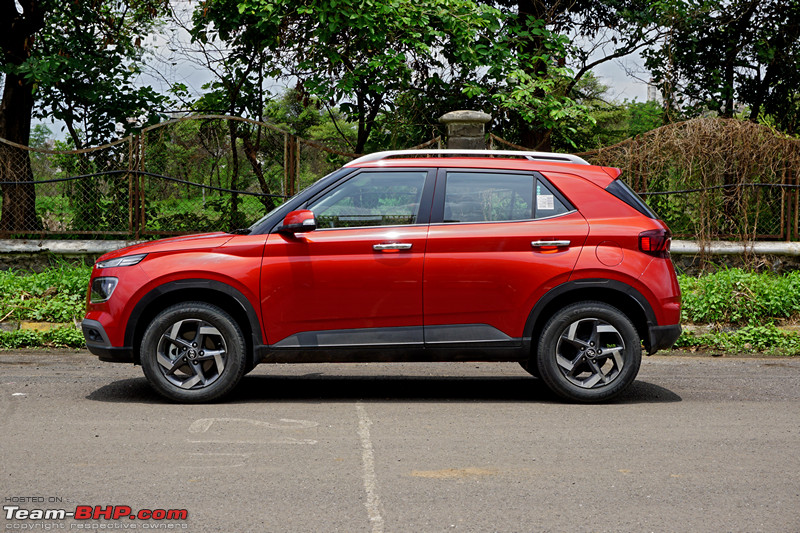 Team-BHP's monthly sales charts over the months reveal that the best-selling cars in the C2 segment are either SUVs or crossovers. Maruti's Vitara Brezza has been a regular visitor on the top 10 cars list of the country. Earlier this year, Mahindra introduced the XUV300, which has turned out to be a strong player. Other cars like the Ford EcoSport, Honda WR-V & Tata Nexon have been doing well too. Hyundai claims that the market share for SUVs has increased from 14% to 23% in the last five years, of which, the market share of the compact SUV (sub-4 meter) segment has increased from 15% to 49% and is expected to grow further. Hyundai has had presence in the crossover space too with the Creta & has enjoyed enormous success with it. The company now wants to replicate that in the lower segments. Some of the Creta's success will definitely rub off on the Venue. The Creta is an expensive crossover and those who can't afford the Creta will very well buy the Venue. That's exactly Hyundai's plan. This car does give you a mini Creta-like experience. To ensure that the Venue sells well, Hyundai has given it a plethora of equipment, including many first-in-segment features. By the look of things, the Venue seems to have started off well too. Our sales chart shows that Hyundai sold 7,049, 8,763 & 9,585 units of the car in the months of May, June & July respectively. Hyundai claims to have garnered 50,000 bookings for the car in 60 days of its launch. At Rs. 6.50 - 11.11 lakhs, Hyundai has also priced it competitively in the segment. Fit & finish are as good as other Hyundai vehicles – in fact, they are among the best in this segment. The car is well built with 69% advanced and high strength steel in its construction; the doors, tailgate and bonnet have a good deal of weight to them. There's very little flex if you press the metal with your thumb. This is despite the fact that the Venue's kerb weight of 1,050 kg for the 1.2L petrol, 1,095 kg for the 1.0L petrol (1,125 kg for the DCT) and 1,160 kg for the diesel makes it lighter than all other monocoque sub-4 meter rivals! The paint quality is as good as we’ve seen in the segment and the panel gaps are even.  To power the Venue, Hyundai have used the 1.2L, 4-cylinder petrol and the 1.4-litre turbocharged diesel engines that do duty in the Elite i20. A 1.0L, 3-cylinder turbocharged petrol is also available. While the 1.4L diesel and 1.0L petrol powerplants are mated to a 6-speed manual gearbox, the 1.2L petrol comes with a 5-speed manual transmission. The 1.0L petrol can also be had with a 7-speed DCT. This makes the Venue the only sub-4 meter SUV to be offered with a dual-clutch AT (EcoSport offered one before). Coming to safety, the Venue is equipped with dual front airbags, ABS + EBD, ISOFIX child seat mounts, impact-sensitive door locks, rear parking sensors, seatbelt reminder (for driver + front passenger) and a high speed alert system as standard. The car is also claimed to meet pedestrian safety norms with a lower stiffener applied to the front crash beam to improve on pedestrian safety. The top variant also gets 6 airbags, ESC, VSM, HAC and a reverse camera. Additionally, you get an IRVM with RSA and SOS buttons. However, features like front parking sensors and TPMS have been left out of the package. Considering the competitors have equipped their cars with these features, Hyundai should have provided them on the Venue as well. As of date, the Venue has not been crash tested by independent entities like the NCAP. Hyundai is offering a standard warranty of 3 years / unlimited km, which can be extended to 5 years / 140,000 km. We strongly recommend this extension. There have already been problems with engine noise, water leaks and fogging of the foglamps in this car. Hyundai is also offering 3 Years Road Side Assistance with the Venue, 3 years Blue Link subscription and a home visit on the 15th day of purchase. Front end is dominated by a large dark chrome and black grille making it look wide, aggressive and in-your-face. While the indicators are on top, the headlamps are lower down on the bumper. Other than the unconventional positioning of the headlamps, the Venue looks similar to a Creta. The car has a good stance, but its smaller size doesn't give it great road presence:  Rear end is very tame compared to the front, and very "hatchback-like". Even with its dual-tone bumper and faux skid plate, we feel it just looks like a beefed up Grand i10 at best. Exhaust pipe is barely visible:  Again, viewed from the side, the Venue looks like a mini-Creta with the blackened A-pillar, floating roof and sharply cut rear door line. The design is well balanced. Use of chrome is restricted to the door handles. Strong character line flows from the bonnet to the tail-lamp:  The Venue measures 3,995 mm in length, 1,770 mm in width and 1,590 mm in height (1,605 with roof rails), with a wheelbase of 2,500 mm. This places it in the middle of the pack among the contenders in the sub 4-meter SUV segment. It is also among the shorter cars in terms of height:  Boxy design, thick black cladding on the sides, roof rails, beefed up wheel arches and strong character lines attempt to give the Venue a rugged look:  What might look like daytime running lights (DRLs) are actually sexy turn-indicators. They sit right on the top:  Small projector headlamps with cornering lights are placed on the bumper. No LED bulbs here sadly, only regular halogen units. LED DRLs surround the headlamp housing. While some feel they look chic, others are of the opinion that they look plain and should have been at the top with the turn-indicators:  With all the lights in action - the LED DRL, halogen projector headlamp, cornering light and turn-indicator right at the top. When you lock the car with the button on the keyfob or the request sensor (on the door handle), the indicators blink once. When you unlock, they blink twice. There is a follow-me-home function as well where the headlamps and tail lamps stay on for a while after the car is switched off. SX and SX(O) variants get automatic headlamp function:  DRLs are bright & prominent, even under sunlight. They come on only when the handbrake is disengaged and dim a bit when the headlights are switched on: 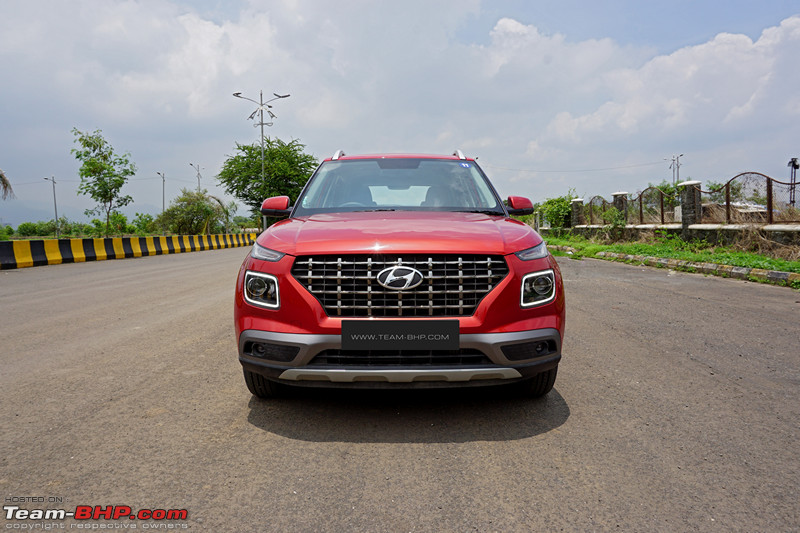 Imposing front grille with dark chrome has a funky weave pattern and an exaggerated 3D effect. It looks more toothy, rather than sporty. Many won't like the design. The chrome looks too garish, but should appeal to the mass market. "H" logo is XL sized:  Dual-tone bumper incorporates an air dam with vertical slats and a large grey insert. Silver plastic skid plate adds to the SUV look, but it is obviously a fake. Foglamps are placed close to the ends. We wish this car also got front parking sensors. The XUV300 gets them:  Tiny projector foglamps are placed way down close to the bottom of the bumper. They are adequately bright. Notice the "+" detailing on the black housing, which resembles the design pattern of the grille. The tiny gaps at the extreme ends (next to the foglamps) are wheel air curtains, which Hyundai claims are a segment-first:  There is an UGLY gap between the foglamps and their housings. This gives it an unfinished + aftermarket look. Not the Hyundai we know:  Tow-hook cap has an arrow indicating where you should press to remove it:  Silver plastic skid plate adds to the "SUV" look, but it obviously has no function on this FWD car. Purely aesthetics. Don't miss the wind deflector:  Gets plastic underbody protection at the front:  Bonnet has four creases, but they are not as prominent as say, the XUV300's. The central bulge is very visible from inside the cabin: 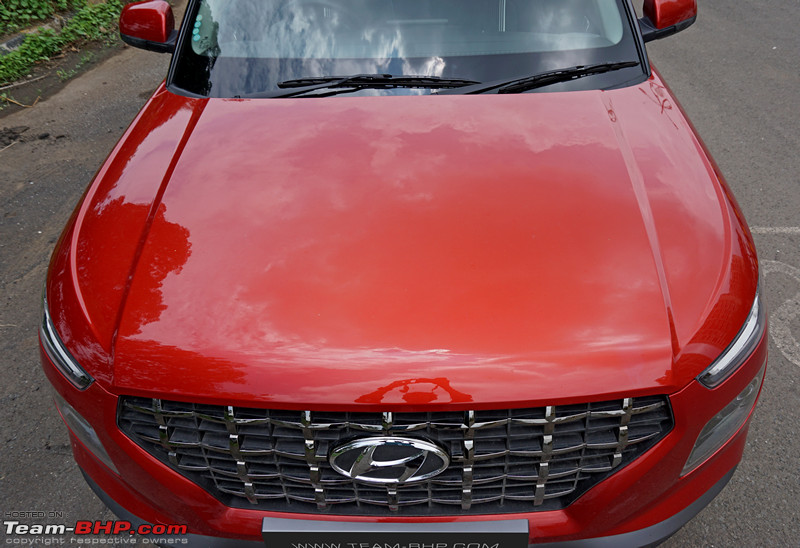 Wiper spindles are concealed under the bonnet...  ...as are the windshield washers:  Both windshield washers squirt out effective sprays (rather than jets) of water. The big wipers have a good sweep:  Panel gaps are even, but not "Hyundai tight" at some places:  They are not much wider around the bonnet...  ...or around the tailgate: 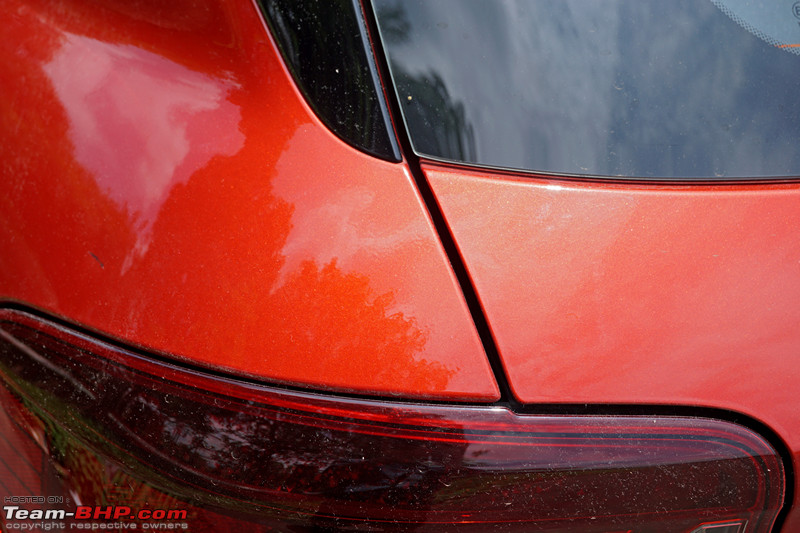 Dual-tone body colour + black ORVMs with integrated LED turn-indicators and silver inserts. They don't match the vehicle's design IMHO. They are too oval compared to the boxy styling of the car. They are electrically adjustable and foldable, but do not have an auto-folding function on lock / unlock. They don't easily move the other way either and I'm worried about damage if a biker side-swipes them:  Small winglets for reducing wind noise on the A-pillar ORVM housing: 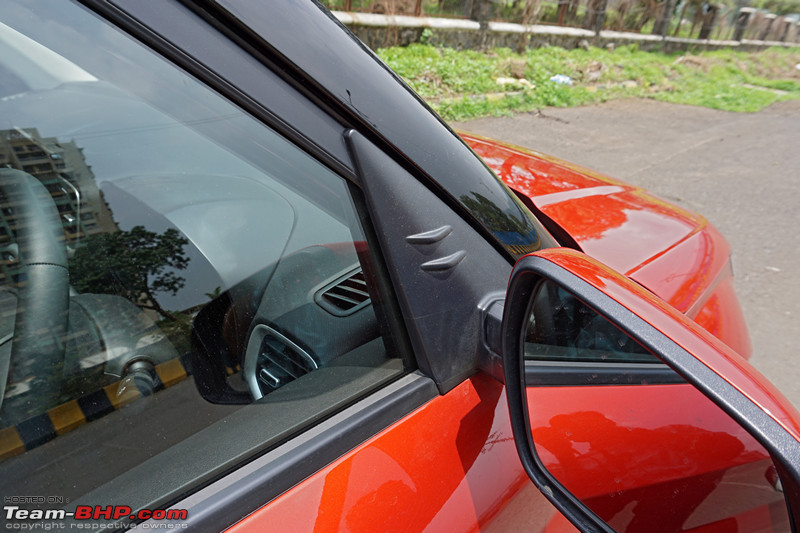 SX (DCT only) and SX(O) variants get a chrome door handle with request sensor on the driver's door. Simply walk up to the car with the key on your person and touch the request sensor to lock / unlock. Keyhole is provided only on the driver's door. No request sensor or keyhole on the front passenger's door:  Roof slopes down slightly towards the rear, while the window line rises. A and B-pillars are blacked out. C-pillar is thick, but the use of a small black panel at the end makes it appear slimmer than it actually is:  Glossy black plastic panel attempts to give a wraparound effect to the rear windshield. However, it could have been sized and matched better to merge with the glass area: 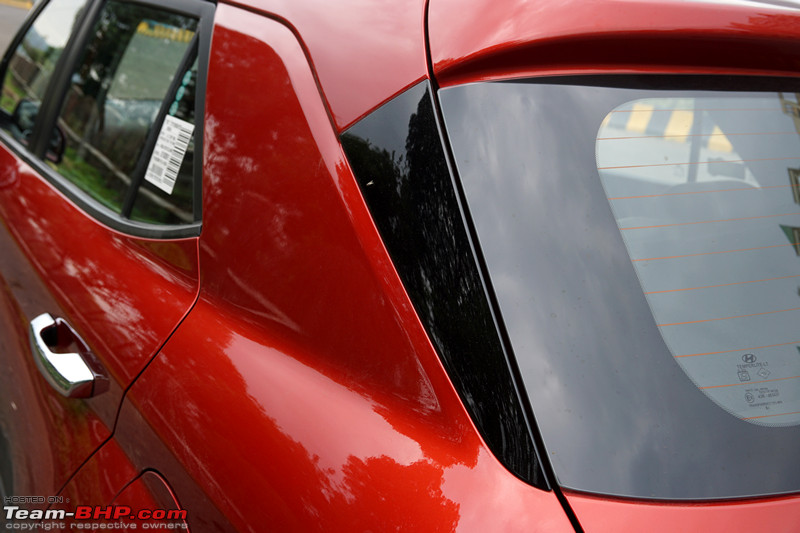 Wheel arches are beefed up at the front...  ...and at the rear. There's a prominent haunch that originates on the rear door and runs across the rear panel & below the tail-lamp:  Black plastic cladding runs along the wheel arches. SX and SX(O) variants get 16" smart-looking black and silver diamond cut alloy wheels shod with 215/60 MRF Wanderer tyres. They fill up the wheel wells fairly well. Like the Vitara Brezza and XUV300, these get 5 lugnuts. E and S variants get 15" steel rims, with 195/65 section tyres:  Prominent crease runs low on the doors. Plastic cladding lends a crossover look. It also sits a lot more flush with the body than in other cars:  Cladding extends all the way down to the frame of the car:  Small mud-flaps located ahead of the rear tyres:  Like most cars in the segment, the Venue gets drum brakes at the back. Only the XUV300 gets disc brakes at the rear as well:  Ribbed roof for better structural rigidity. SX and SX(O) variants get a very-welcome sunroof:  Barring the base E trim, all variants get silver raised roof rails:  Sharkfin antenna sits at the rear of the SX and SX(O) variants. S variant gets a micro (stubby) antenna:  Tailgate gets a subtle and neatly integrated spoiler:  Black windshield washer is nicely integrated in the spoiler. HMSL is placed inside the car: 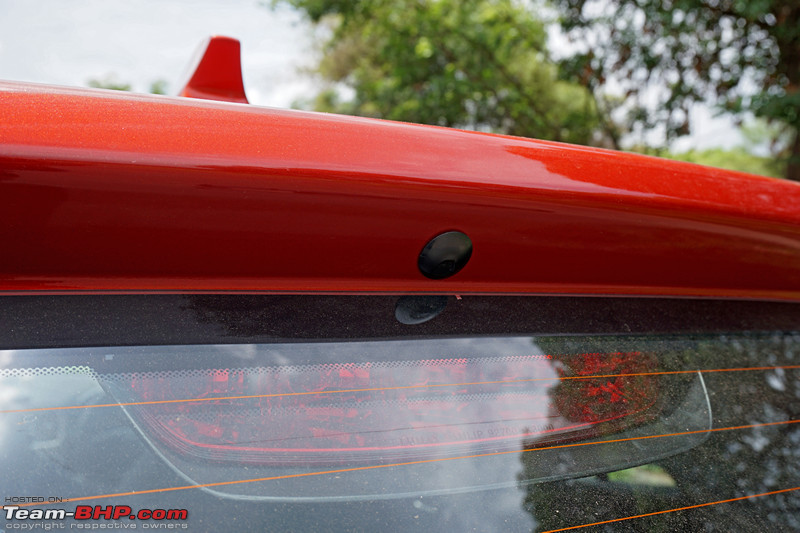 Wraparound LED tail-lamps have lenticular lenses for giving out a crystal effect, halogen turn-indicators and reflectors on the sides. They look smart!  Funky LEDs come on when the pilot lights are started. Neither cluster gets a reversing lamp or rear foglamp. On applying the brakes, only the slanting LEDs in the middle light up: 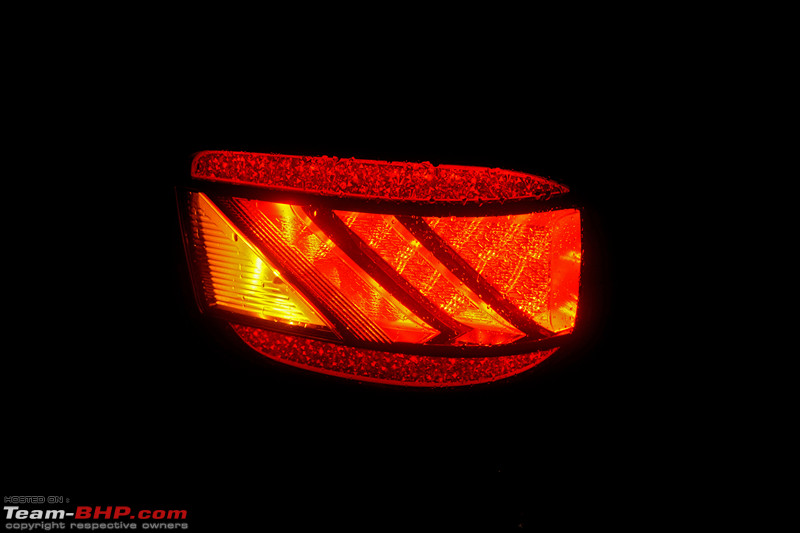 Tailgate bears a resemblance to the Grand i10's. It has strong creases running along its length and houses a large chrome "H" badge and bold V-E-N-U-E lettering. Thankfully, the use of chrome is restricted to the badging only. Rear windshield is proportionately sized:  Only the SX(O) variant gets rear wash + wipe. How stupid. Rear wiper has a good sweep and does a great job. In torrential rain, it really helped in keeping the rearward view safe. Barring the base E variant, all variants get a rear defogger: 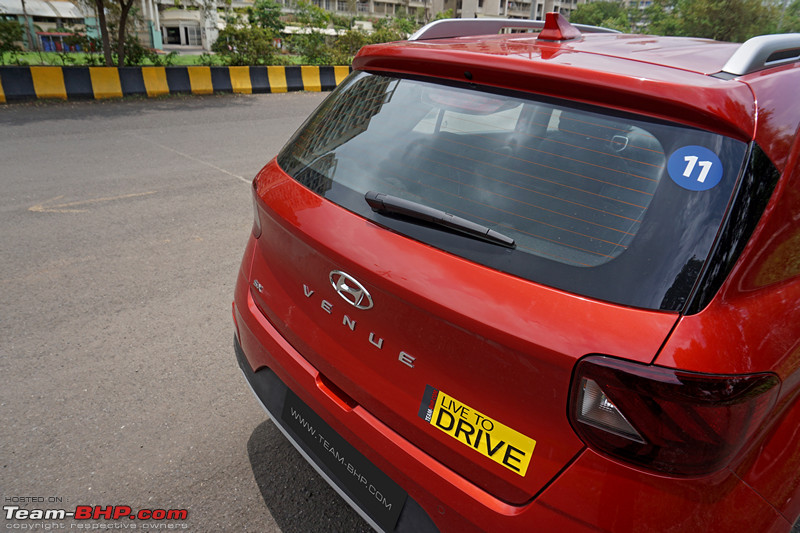 Variant badge on the left side of the tailgate. No engine badging (anywhere on the body):  Like the front bumper, the rear one is a dual-tone unit too. It houses two reversing lamps and a faux silver skid plate. Only two parking sensors have been provided (on all variants). It also has a cutout at the top to lift the tailgate. The electromagnetic release for the tailgate is located here as well. A large black insert breaks the visual monotony:  SX and SX(O) variants get a reversing camera. It is neatly integrated and located just above the number plate, between its two illuminators:  Both parking sensors are placed towards the middle area of the bumper: 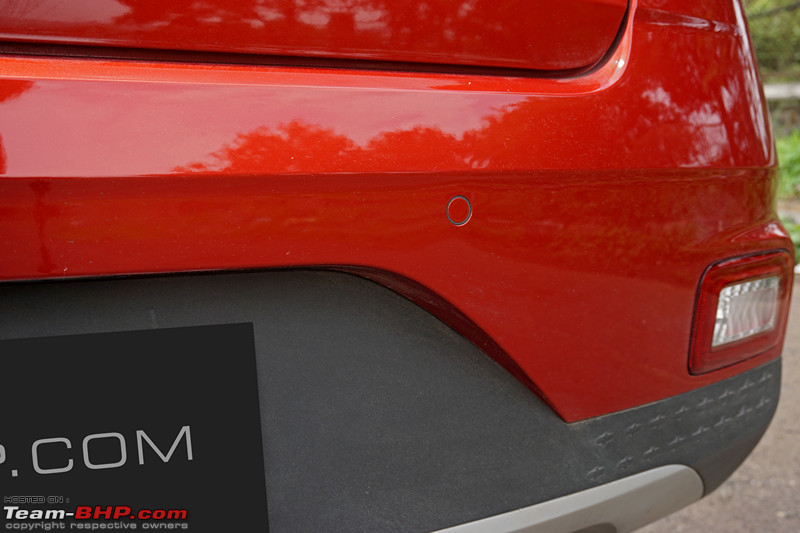 White halogen reversing lamps are located at the ends of the bumper. They have thick reflectors around them: 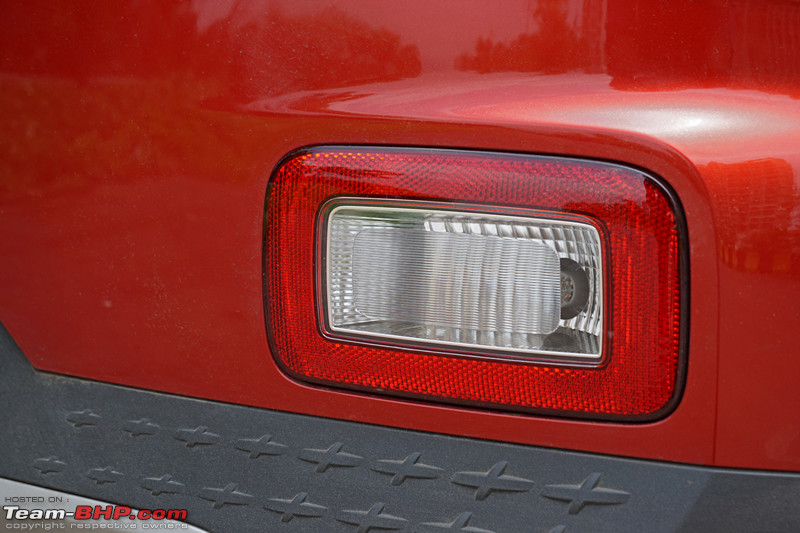 Black insert on the rear bumper has the same "+" detailing as the front unit: 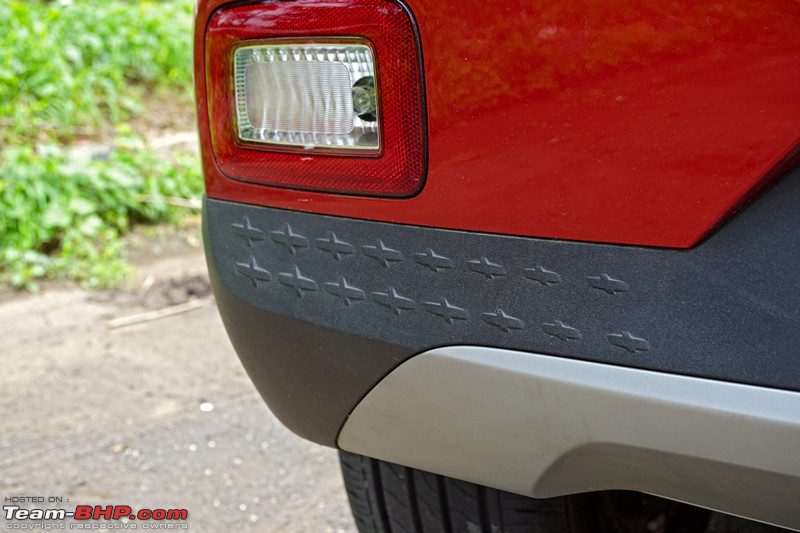 Faux silver skid plate is small and only for enhancing the cosmetic appeal:  Rear towing point is located in the center:  Alongside one of our favourite cars in the segment:  Tailgate-mounted spare gives the EcoSport a more SUV'ish look than the Venue's hatchback-like rear:  From the side. Venue is more boxy than the EcoSport:  Last edited by GTO : 23rd September 2020 at 07:13. Reason: Not the Santro Platform |
| |  (54)
Thanks (54)
Thanks
 |
| The following 54 BHPians Thank Aditya for this useful post: | 2himanshu, Abhinav V, AjinkyaP, akshay81, arbaz906, Bee, binoyyj, bullock-Car, carrazy, ChiragM, CrAzY dRiVeR, dailydriver, Dani7766, darklord, Déesse, Gaboonviper04, Gannu_1, GTO, HarshGtR, hemanth.anand, InControl, jailbird_fynix, jithin23, JoseVijay, lemedico, MDED, Motor_Nut, MSAneesh, N33raj, Nazaar25, neil.jericho, phoenixash, Ponbaarathi, PraNeel, Punatic, RaghuVis, RavenAvi, samabhi, Samba, sandx, Simat, sukiwa, sunny29584, sunsivj, theexperthand, The_Outsider!, TusharK, uday.ere, vaasu, vaish9925, Varun_HexaGuy, vb-saan, Vik0728, Vysakh |
| | #4 |
| Team-BHP Support  | Interior - Front  The front doors open and shut in a triple-stage action. As mentioned earlier, they are not light like those seen in some other Asian cars and feel good. The doors open wide enough & the running board is not wide. The floor of the car is not as high as traditional SUVs, while the roof is on the higher side. So, occupants will not have any problem while getting in. Once inside, the Venue has excellent legroom, although 6 footers might find the headroom to be limited. Although the front & rear windshields are well sized, the roofline slopes down and I found the rear windows to be on the smaller side. Still, there is enough light entering the cabin. However, the cabin appears smaller in size to its competitors and the interiors have an all-black theme, which makes it feel rather "cosy" inside. The styling of the dashboard is functional & contemporary. Silver inserts help break the black monotony. The doorpads, seats, carpets and floormats are black as well. While this is cleverly thought out as it will do well to conceal any signs of soiling, it can make the interior look smaller than it actually is. Thankfully, the roofliner is whitish-grey. However, we still feel that a dual-tone (black + beige) option would have helped make the cabin appear more airy. While there are dual-tone interiors available, they can be had only with certain exterior colours. As expected for this segment, the plastics on the dashboard are all hard. The quality of the plastics is certainly better than the Venue’s main rivals in the segment though. Every part is well-finished and there are no rough edges anywhere. Typically Hyundai! The seats get a combination of fabric and leatherette (artificial leather) upholstery. There is some leather applied on the door armrests, front central armrest, as well as the gear knob + steering wheel. Ergonomically, the cabin is well laid out and all controls are easy to find and reach. It is very easy to find your perfect driving position. The feel, quality and finish of the buttons and switches is satisfactory. Many of these are shared with other Hyundai cars and feel like they are built to last. Hyundai have loaded the interior with features such as auto headlamps, an 8-inch audio video navigation (AVNT) touchscreen head-unit with telematics (Blue Link) that supports Android Auto and Apple CarPlay, electric sunroof, wireless mobile charging and air purifier. However, some essential features such as auto wipers and auto dimming IRVM have sadly been skipped. Black dashboard with silver inserts is logically laid out. The entire cabin is practical, user-friendly and equipped with likeable features. Ergonomics are spot on as well:  Dashboard is well-screwed together and nicely finished. One can't find any rough edges anywhere: 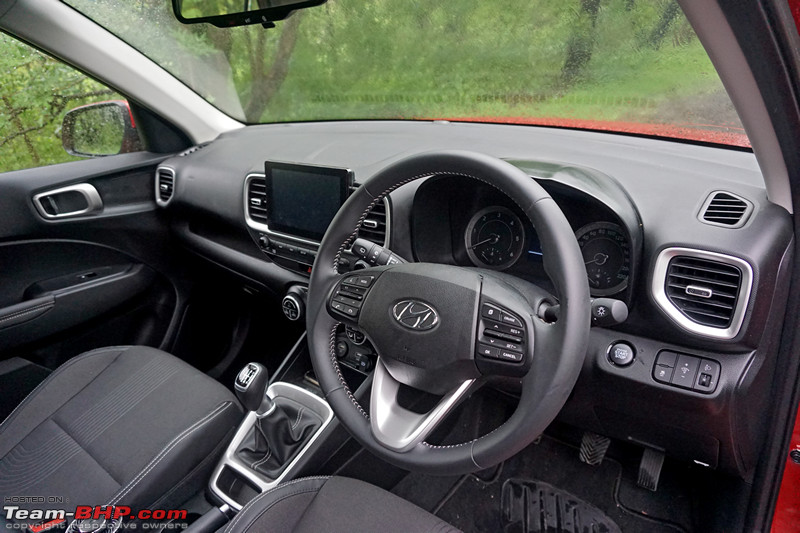 Cowl on top of the instrument cluster looks cheap. But, it is well finished with no rough edges:  Dashboard features what Hyundai calls a "laser cut" finish. I found it attractive:  Windscreen is large and offers a good view of the road ahead. The seating position is a little high up, but it's more like a tall hatchback than an SUV. Some will appreciate that they can view the bonnet while driving: 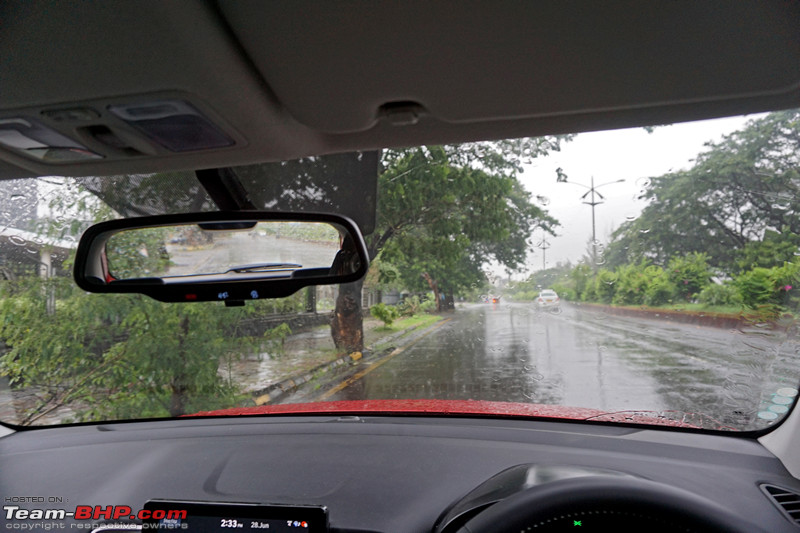 A-pillars are not excessively thick and do not cause blind spots (EcoSport is the extreme opposite). Lateral view and all-round visibility are good:  Smart leather-wrapped steering wheel has a silver insert and thumb contours. It is just the right size and has just the right thickness. Steering feels great to hold and offers satisfactory grip. Looks and feels very premium. The steering-mounted controls have large buttons, which makes their operation easy. However, I feel there are too many buttons on the wheel and it looks extremely cluttered! The hornpad isn't easy to reach for those with shorter thumbs. It is light to press though: 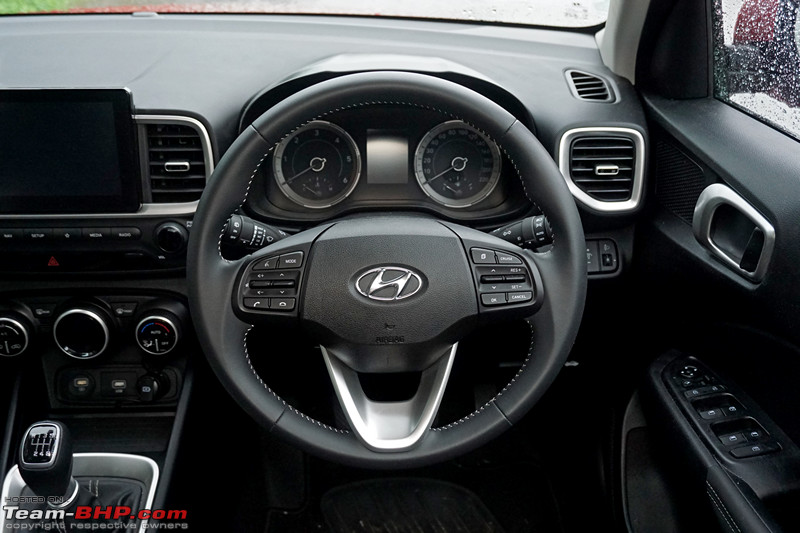 Buttons for the infotainment system, telephony and voice commands are placed on the left spoke. Mute function (very useful) can be operated by pressing the volume button inward. Pressing the mute button also pauses the song that's playing, so you don't miss any part of it. What we found weird was that to go to the next track, you have to push the track button down - opposite of what is usually the case. We saw this in the Hector as well. New trend? Buttons for operating the MID and cruise control are placed on the right spoke:  Zooming in to show you the perfect stitching pattern on the steering:  Steering can be adjusted for height only, not for reach - even in the top spec! This is a shocking omission as a reach-adjustable steering greatly contributes to the 'perfect' driving position. The EcoSport, which is the oldest car in the segment, gets it. What is even more surprising is that from the Hyundai stable, even the cheaper Elite i20 gets it. Hyundai ought to realise that such cost cutting doesn't suit its brand image:  Engine start/stop button has a glossy black ring around it. Should have had a brushed silver outline which is there on the door handles and air-con vents. The button glows in a cool blue every time the door is opened:  Simple instrument cluster is easy to read. Tachometer on the left & speedometer on the right (just the way we like it). Analogue temperature & fuel gauges too, with an MID in between. Meters are backlit in white - very classy. While the tachometer of the diesel is marked till 6,000 rpm...  ...the one of the petrol is marked till 8,000. Both the engines are free-revving in nature:  A system check is performed every time the car is started. The odometer is shown every time the door is opened: 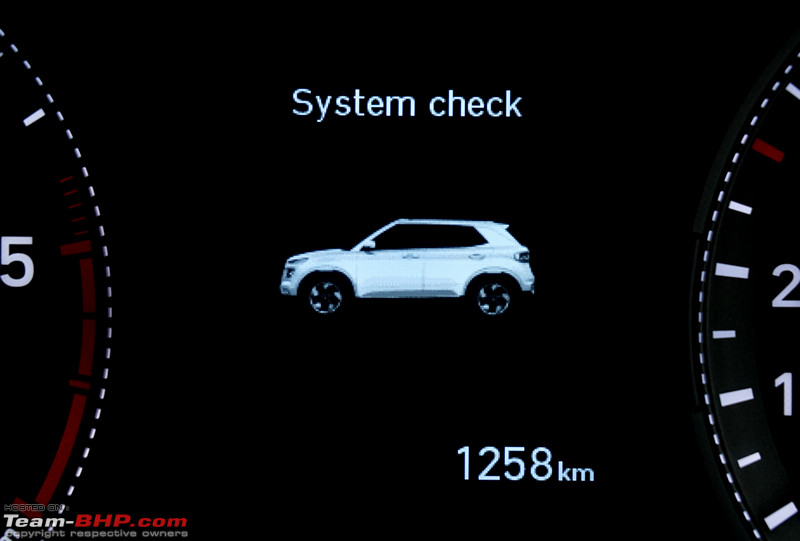 The MID shows average and instant fuel consumption, distance-to-empty counter, a single trip meter, digital speedometer & outside temperature reading. The trip meter shows the distance travelled, average consumption and time taken. The MID further shows a summary of the drive when you switch the car off: 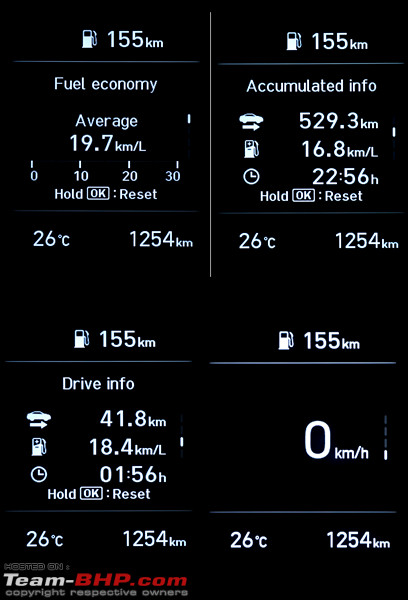 To change the MID settings, engage the handbrake (parking gear for the automatic). Parameters that can be customised include functioning of the auto-locking & unlocking of the doors... 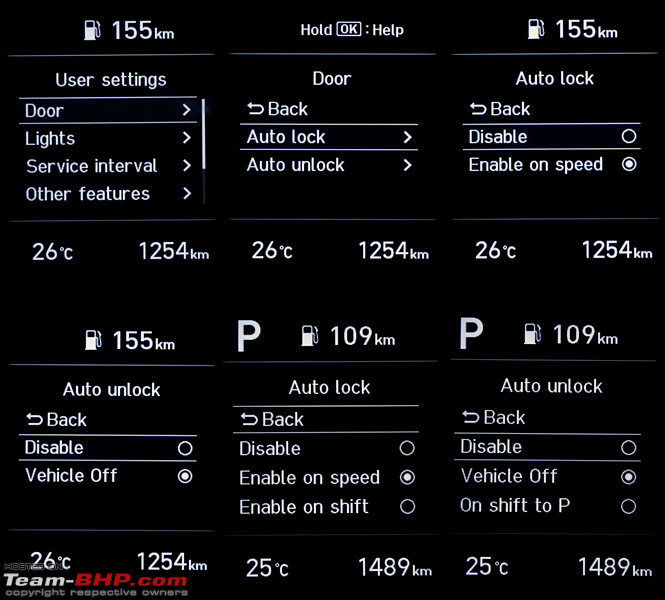 ...follow-me-home lights and number of flashes for the 'lane change indicator':  The illumination of the instrument cluster has 21 levels of adjustment! Talk about fine-tuning. The automatic variant shows which gear position you have engaged. In the MT, a gearshift suggesting tool has been provided. The parking sensor display comes up as soon as reverse gear is engaged:  Other readouts that can be altered include the auto reset of the fuel economy, the display of the fuel efficiency readouts and the temperature unit of measurement. When you change the temperature unit, the display on the climate control system also changes accordingly:  The MID tells you when the service is due, in terms of months and kilometers. These can be altered by the user (default was 10,000 km / 12 months which is the recommended interval):  MID displays the specific door that is open. It also tells you if the bonnet or tailgate are open. Love this, as the "bonnet open" warning is usually seen only in premium cars. It sensibly warns you if the sunroof is open only when the engine is switched off: 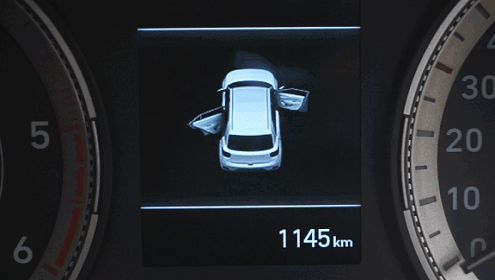 The automatic variant has a "Convenience" option, which displays the order of the gears (on the shifter) - very cool:  Stalks exude quality! As has been mentioned before, the quality of plastics is very good for this segment. Left stalk controls the functions for the front and rear wipers, whereas the right stalk controls the headlamps and front foglamp. While automatic headlamps have been provided, automatic rain-sensing wipers have been left out, even on the top variant. Sucks as we find auto-wipers to be incredibly useful in the monsoons. Lane change indicator is standard on all variants:  Air-con vents are symmetrical. They have a thick silver border (which looks awesome) and silver inserts on the air flow direction controller. The air flow can be shut by moving the direction controller to the extreme left. However, even with the vents in full shut position, some air keeps flowing out:  Switches for dash illumination and headlamp level adjustments are located below. The traction control off button is also located here (don't ever use it unless starting off on slippery surfaces like slush & snow):  OBD port located at the base of the fusebox. Like some other Hyundai cars, fusebox gets a Master 'On / Off' switch which could help prevent battery drain when the car is parked for a long duration:  Sturdy bonnet release lever is located next to the fusebox:  Fuel flap release lever is placed conventionally on the floor:  Like the dashboard, the doorpads get an all-black colour theme. This will prevent them from getting soiled. The doorpads are well finished with no sharp edges anywhere. They are scooped out where you would rest your arm - that smartly frees up room:  Metal finish door handles are standard on all variants of the Venue. They feel sturdy & look fabulous:  While the plastics are all hard, the armrest is padded and covered in leather. White stitching looks cool:  Console houses the usual set of buttons. Only the driver's window gets one-touch up/down and anti-pinch functionality, and only the driver’s window button is backlit. Door mirrors are electrically foldable. ORVM adjuster selector switch is weird. One of the two mirrors is always selected - there is no middle / dead position. So, if by chance, you press the adjuster, one of the mirrors will change its angles. ORVMs can be closed electrically even after the engine is switched off. The opening and closing actions are damn silent. Hyundai always impresses with the little things: 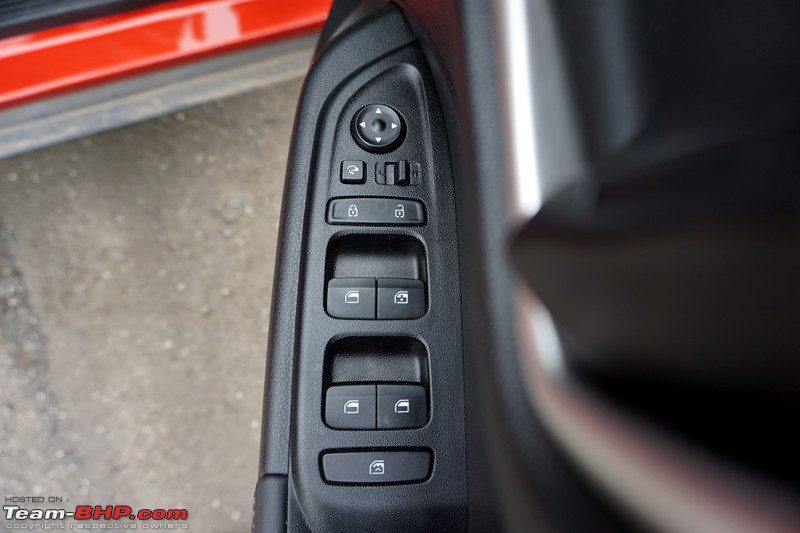 Doorpad can hold a 1-liter bottle, and other small items: 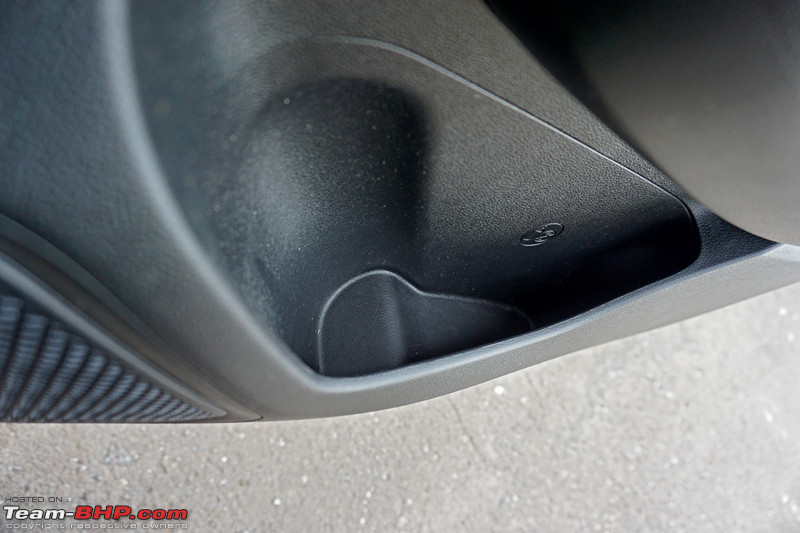 A look at the doorpad of the SX variant:  No leather cladding provided on the armrest:  Front seats of the SX(O) variant are draped in a combination of fabric and leatherette upholstery, and are wide enough to suit even larger drivers. Under-thigh support is good. Although lumbar adjustment is not provided, lower back support is satisfactory as well. The firmness of the seats is adequate and the headrests are soft + adjustable. Overall, we found that the driver's seat offers satisfactory support even on long drives:  A look at the fabric upholstered seats of the SX variant: 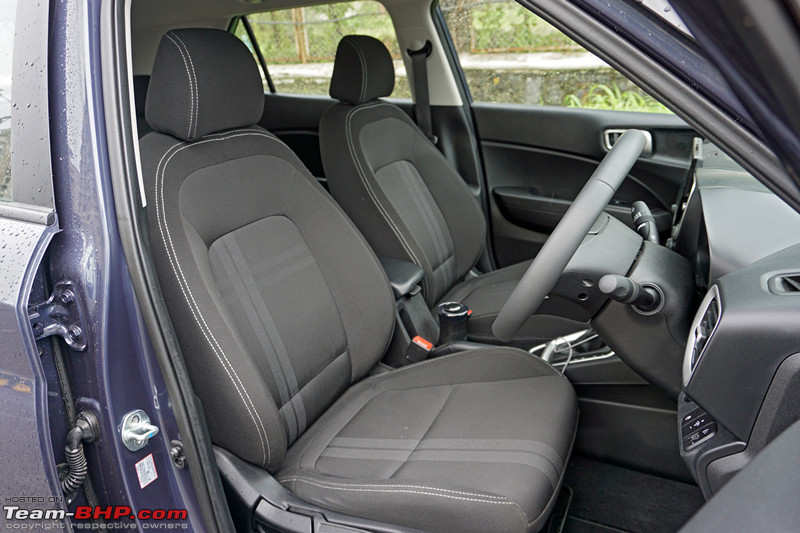 Levers to recline the seat and adjust its height don't feel particularly solid. Height adjustment for the driver's seat is there in the SX and SX(O) variants only:  Fore & aft travel range is enough to accommodate tall & short drivers alike:  Height adjustment range is healthy as well. Short or tall, no one will complain:  Seat upholstery is a combination of fabric and leatherette (artificial leather). Contrast stitching on the sides looks cool. Like most Hyundai cars, the quality of materials used is good:  A look at the design pattern on the backrest:  A close look at the fabric upholstery pattern of the SX variant: 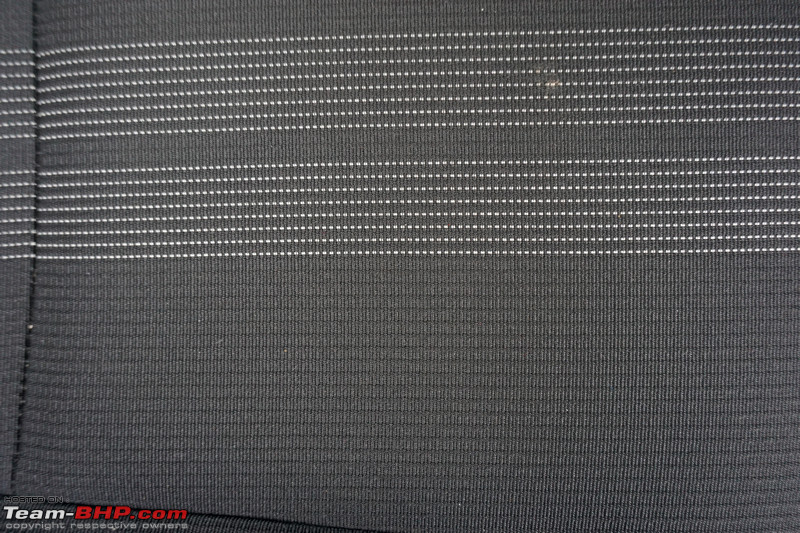 Useful center armrest has a soft leather cladding:  Armrest slides forward for reach, making it easy for shorter drivers to use as well. It cannot be adjusted for height though (usually seen only on premium cars):  SX variant does not get an adjustable armrest though. No leather cladding either, unless you order a dual-tone exterior colour scheme:  Seatbelts are not height-adjustable. While they are placed at a comfortable height, this is still a disappointing omission! Both front seatbelts get pre-tensioners: 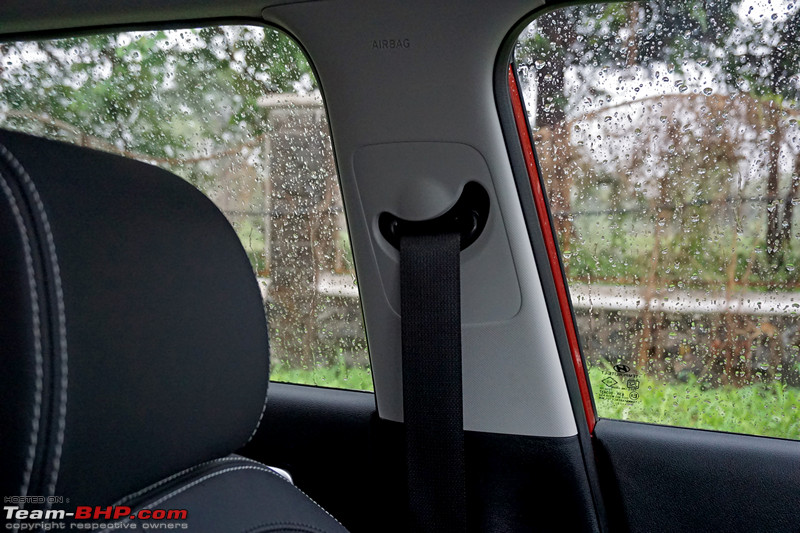 Pedals are properly spaced out. A very useable dead pedal has been provided as well:  A peek at the AT’s footwell:  ORVMs are sufficiently tall, but could have been wider:  IRVM is very unique and looks upmarket. It is wide enough to cover the entire rear windshield:  IRVM houses 3 buttons - SOS button will place an emergency call to Hyundai customer care, the button with the tow truck will call Hyundai Roadside Assistance and the third button will launch Blue Link. However, for all these advanced features, Hyundai has not provided the auto-dimming function - a huge miss!!! You get a standard day / night manual flick switch:  The rearward view is just average. The rear windshield is fair in size, but the C-pillars are thick. Better to rely on the reversing camera and parking sensors:  Center fascia tilts slightly towards the driver. It features a floating touchscreen head-unit. A thick silver border runs around the air-con vents, climate control display + switches and gear console. Piano black has been used around the hazard light switch:  Recessed area on top of the dashboard to place your favourite deity:  Tablet-like 8-inch touchscreen infotainment AVNT head-unit with HD display is standard on the SX DCT and SX(O) variants. It's covered in detail in a separate post: 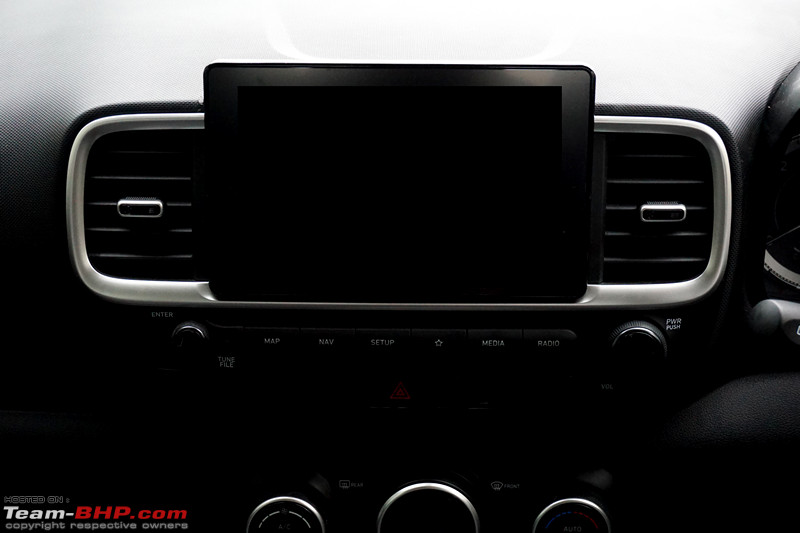 Upmarket and easy-to-read climate control system gets piano black buttons and silver inserts. The blower has 8 levels of adjustment. At levels 1 and 2, it is silent. At levels 3 and 4, it gets audible. At levels 5 and 6, it is loud, while on levels 7 and 8 - the noise is excessive. The lowest temperature that the system goes to is 17 degrees centigrade before hitting 'LO', while the highest temperature level is 27 before hitting 'HI'. The cooling performance is very impressive. Even in sweltering heat outside, the interiors were chilled quickly. Negatives? The blower, even on level 1, throws out more air than you expect. Should have been a little lesser. Hyundai has equipped the Venue with Eco Coating - a technology that is claimed to eliminate air-conditioner odour:  2 USB ports and a 12V power outlet are located below the climate control system on the center fascia. The USB port on the left can only be used for charging, while the one in the middle can be used to connect your smartphone to the infotainment system as well as for charging purposes. 12V power outlet gets a flip-up plastic cover. Nope, there's no Aux-in port:  Hyundai has provided a plug-in USB port that can be slotted into the 12V charging socket. It comes with a plastic cover. Pretty sweet!  The base of the center fascia features a wireless smartphone charger - a first-in-segment feature. Remember, your smartphone needs to have the wireless charging function for this feature to work. Lights to indicate the various functions of the smartphone charger on the bottom right. Warnings have been printed asking you not to place coins or the smartkey here: 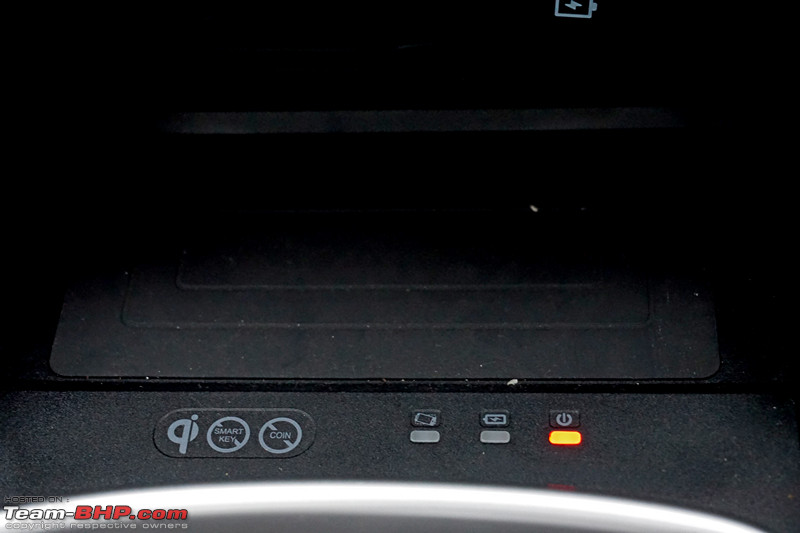 Bird's eye view of the handbrake console:  Narrow storage space behind the gear lever has a rubberised base:  The SX DCT and SX(O) variants come with an air purifier. It has 3 modes of operation - auto, standby & manual and works only when the car's engine is running. It has an operation switch at the top, a fan speed controller and an air quality indicator lamp. The purifier operates in standby mode when the engine is started. In this mode, the air quality measurement sensor is in a preheating stage for 150 seconds. A yellow lamp blinks slowly on the top. In auto mode, the fan speed of the purifier changes according to the air quality. The lamp colour changes as well. In manual mode, the fan maintains the speed set by the user and the lamp colour changes according to the air quality. Long-pressing the operation switch will turn the purifier off. If you press the switch again, the purifier will be turned on. The fan has 4 speeds - low, mid, high and turbo. Short turns of the fan speed controller will increase / decrease the fan speed by one step. Long-turning the controller with take the fan speed to the extreme levels (low / turbo). Short-pressing the operation switch will change the fan speed automatically, according to the air quality: 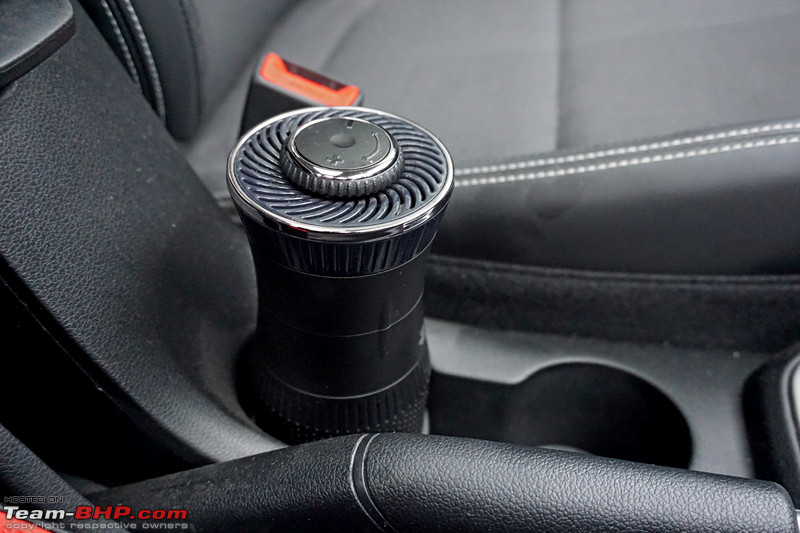 Air quality is shown via the indicator lamp. Red = very bad, yellow = bad, green = average, blue = good. What is irritating is that the purifier beeps from time to time as it operates. At the start, it took me a while to figure out what was beeping in the car. When I found out it was the purifier, I turned it off:  Sensor unit is located on the side of the purifier:  The air inlet is located in the lowest part of the purifier. It has a filter, which Hyundai recommends should be replaced once in 4 months. The air purifier has a warranty of 3 years / 60,000 km:  Docking port for the air purifier is located in one of the cupholders on the center console. It cannot be removed:  Center armrest has a deep storage compartment underneath. It has a soft lining on the floor:  Long and fairly deep storage space above the glovebox gets a lip to keep stored items from falling. This is a good place for the front passenger to keep his smartphone and other small items. Just be sure the doors are locked & the window rolled up to reduce the odds of theft:  Glovebox is medium-sized: 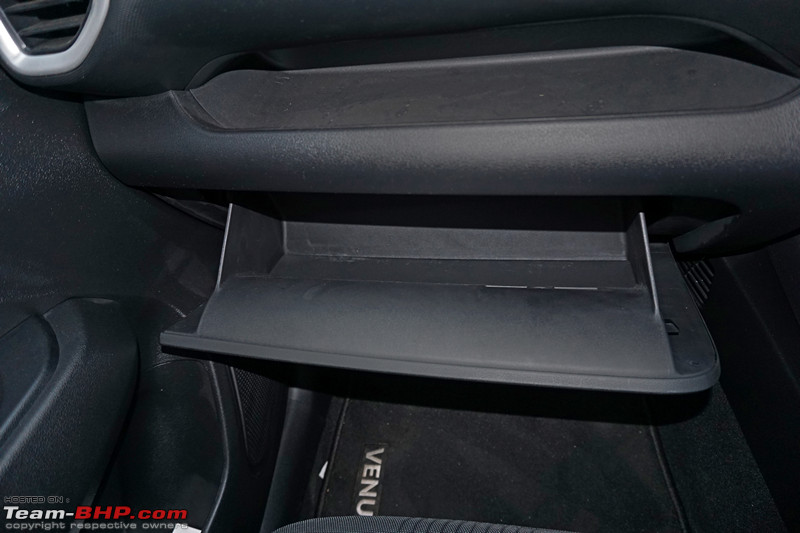 It has a card holder, but doesn't get illumination: 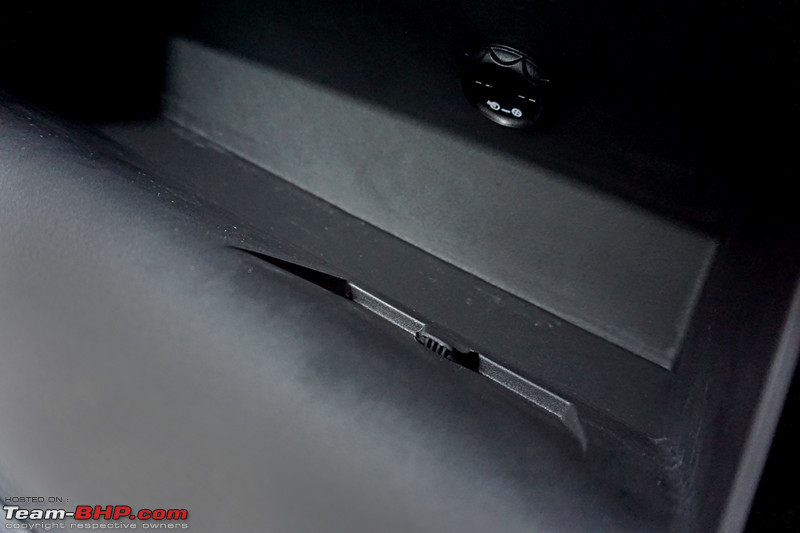 A cooling vent has been provided though:  Roof bezel consists of map lights and sunroof controls. After locking the car, all cabin lights go out with a theatre-dimming effect. Even if the cabin lights are left in the ON position, they will go off when you lock the car from outside (to prevent battery drain). No sunglass holder provided:  Bluetooth mic is positioned above the driver on the roofliner. It should have been integrated in the roof lamp console for a cleaner look IMHO:  Sunvisors are economy-grade in design, yet they don’t feel flimsy. Driver-side unit merely gets a flap to hold tickets, but no mirror or illumination:  Passenger-side sunvisor gets a vanity mirror, but there's no cover or light provided. When did Hyundai start counting its pennies?  Dual airbags are standard on all variants of the Venue. SX(O) trim gets 6 airbags in total. These include…  …side airbags (no seat covers here please)…  …and curtain airbags: 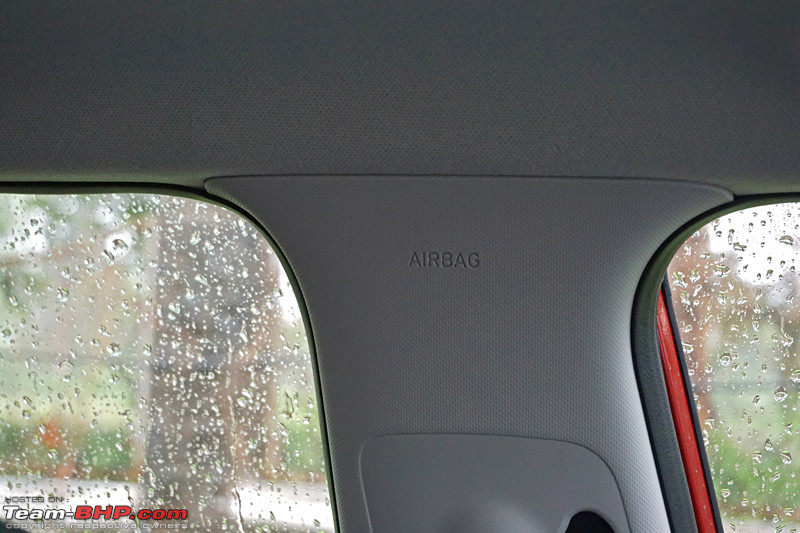 Sunroof cover is manually-operated, as is usually the case in this price band:  The size of the sunroof is just adequate for the cabin:  You can pop it up for ventilation by pushing the sunroof button upwards: 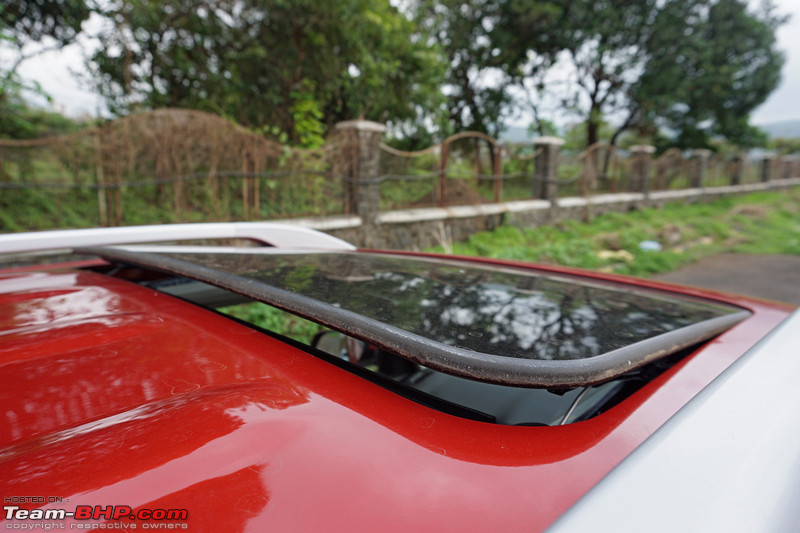 With the sunroof (or even its cover) open, a lot of light comes into the cabin. This is the max it opens to:  As is usually the case with Hyundai, things are neat and tidy even in places where most owners won’t look. There are no loose wires or cables dangling anywhere. Here's a sneak peek below the dashboard in the driver's footwell...  ...and the passenger's footwell:  Last edited by GTO : 19th September 2019 at 10:56. |
| |  (37)
Thanks (37)
Thanks
 |
| The following 37 BHPians Thank Aditya for this useful post: | 2himanshu, Abhinav V, AjinkyaP, akshay81, Bee, carrazy, ChiragM, dailydriver, Dani7766, darklord, Gaboonviper04, Gannu_1, GTO, InControl, jailbird_fynix, JoseVijay, lemedico, MDED, MSAneesh, N33raj, PapaKiloSierra9, phoenixash, RaghuVis, RavenAvi, rohitlp, samabhi, Samba, SanSabh, Sheel, Simat, SS-Traveller, sukiwa, theexperthand, The_Outsider!, uday.ere, vaasu, vb-saan |
| | #5 |
| Team-BHP Support  | Interior - Rear The rear doors of the Hyundai Venue open and close in a two stage action. They swing out sufficiently wide, the roof of the car is pretty high and the floor isn't too high off the ground. This makes ingress & egress convenient for most people (including the elderly). The rear seat is placed at a comfortable height as well:  There is enough space between the seat and B-pillar to move your feet in & out:  Like the front doorpads, the ones at the rear have an all-black theme. The rear speakers are housed in them: 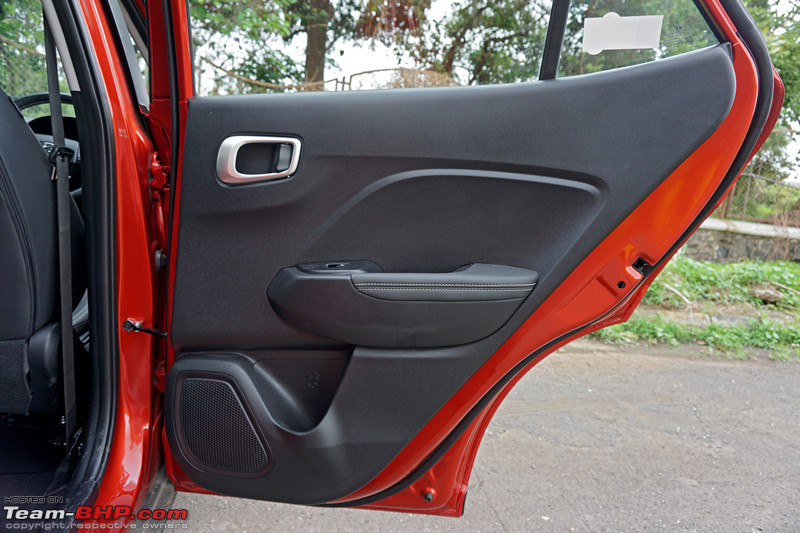 Again, like the front, the rear doorpads are made of hard plastic, but there is a soft leather cladding with white stitching for the armrest:  Door pockets can hold a 1-liter bottle and some knick-knacks:  A look at the rear doorpad of the SX variant. No leather for the armrest here:  Rear seat is more suitable for 2 adults and a child, rather than 3 adults. While the seatbase is largely flat, the seatbacks have some contours to hold you in place:  A look at the fabric upholstered seat of the SX. Even this variant gets adjustable headrests, but there is no center armrest:  Legroom is sufficient. Not cramped, but not excessive either:  Both side occupants get soft & adjustable headrests. Nothing for the middle passenger though. Side occupants get three-point seatbelts, while the middle passenger gets a lap belt:  Seatbelt buckles are housed in dedicated cutouts in the rear seat: 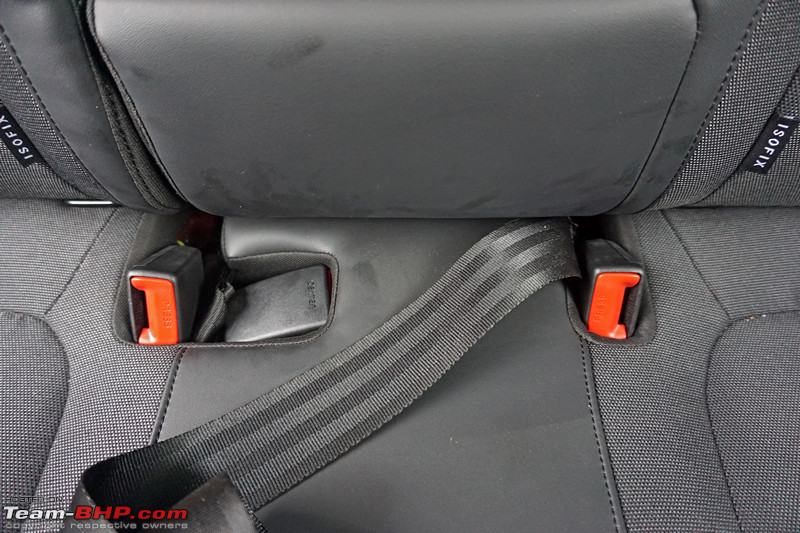 ISOFIX child seat anchors have been provided on both sides. This is a standard feature in all variants of the Venue:  A look at the maximum and minimum legroom available:  With the front seat in my 5'10" driving position, I have about 3" of knee room to spare. With the front seat moved all the way back, my knees almost touch the seatback. Luckily, the seatback area of the front seat is soft, thus it doesn't hurt: 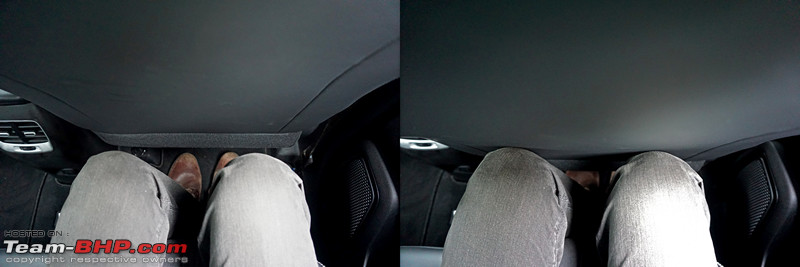 The seatback has a comfortable angle. There is enough thigh support for adults up to 6' in height. Both headrests are adjustable & useful:  The seatbacks of the front seats are slightly scooped out & soft, freeing a little more room for the rear passengers:  The surface at the base of the seats is soft, so it won't hurt your legs. There is enough room under the front seats to tuck your feet in:  Roof liner is scooped out at the rear to release some additional headroom:  Headroom is generous. At 5'10", I had ~3" of clearance. Notice the rising window line. While that doesn't pose an issue for taller occupants, short folk might have a problem. Along with the black interiors, this can make things claustrophobic:  The center armrest is positioned at a comfortable height:  It is wide & soft, and comes with two cupholders:  Yep, the window rolls all the way in:  Seatback pocket only for the left side passenger. It is wide and fairly deep. Why Hyundai couldn't give it on both seats is beyond us:  The Venue gets rear air-con vents. These are provided from the S variant upwards. While there is only one common air volume controller, their direction can be adjusted individually. The air-conditioner is very effective:  12V power outlet sits below the rear air-con vents. No USB port for the rear passengers to use (buy a converter online):  Spring-loaded grab handles have been provided above all passenger doors. Only rear-right unit gets a coat hook:  Seatbelts can be parked in these slots (when folding the rear seat down):  Whitish-grey roofliner dips down where the sunroof is located. 2nd cabin lamp is placed behind the sunroof, hence serving both (front & rear) seat rows:  Cabin lamp has one switch with the usual 3 positions ("on", "door" and "off"). It functions independent of the front cabin lamps:  The floor hump is on the taller side. This, and the air-con unit, will restrict legroom for the middle passenger & annoy him. It will be best for him to place his feet on either side of the floor hump:  350-liter boot is at par with the Tata Nexon's. It is large enough to accommodate luggage for weekend family trips. Bigger than the Vitara Brezza and XUV300, but smaller than the EcoSport and WR-V. The opening is not very wide and the loading lip is high, which makes it a bit inconvenient to load luggage:  Large parcel tray comes with a recessed area and prominent border to keep things from rolling onto the rear seat:  Parcel tray has strings which attach it to the tailgate & lift it up when you open the boot: 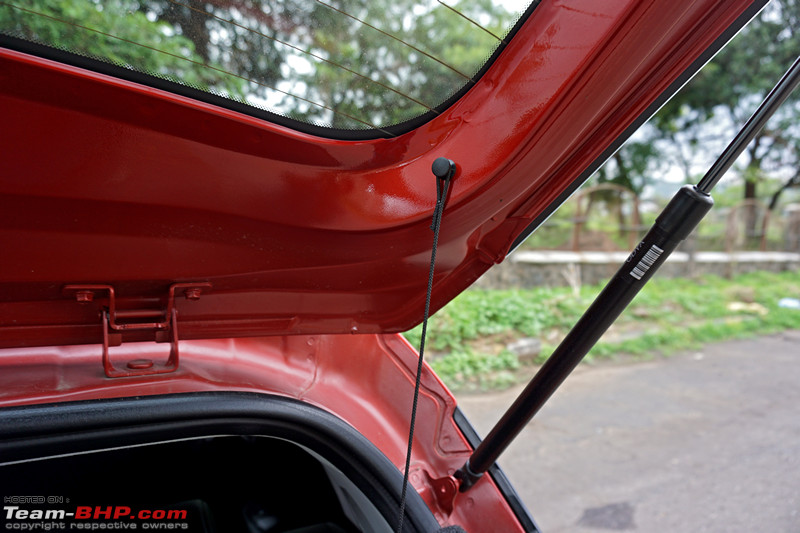 Removing the parcel tray makes the boot look bigger. The family's weekend luggage should easily fit in here:  Boot light is located on the right: 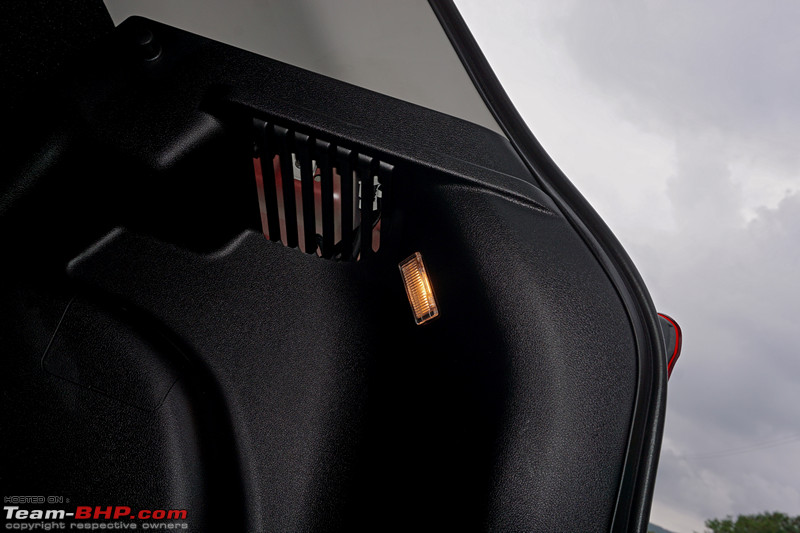 For increasing cargo space, the rear seats can be folded down. Pull this strap up to unlock the seatback: 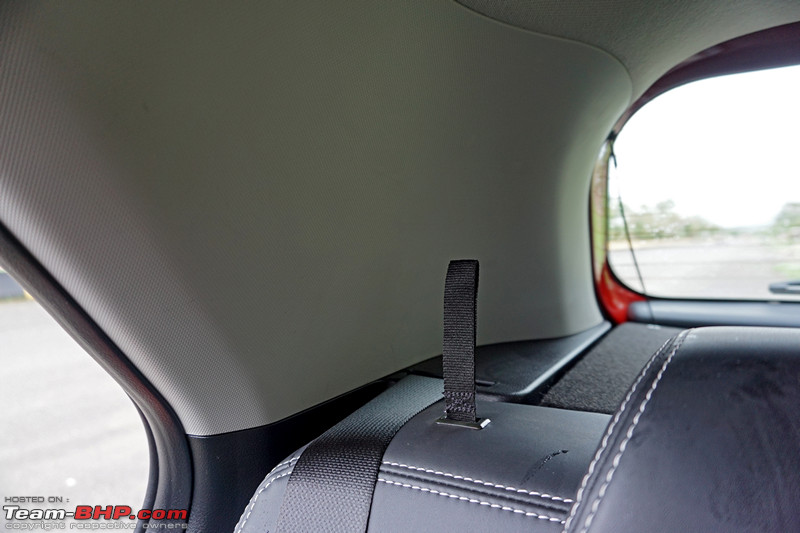 Rear seat has a split in a 60:40 ratio. The seatbase is fixed and cannot be tumbled forward like the EcoSport: 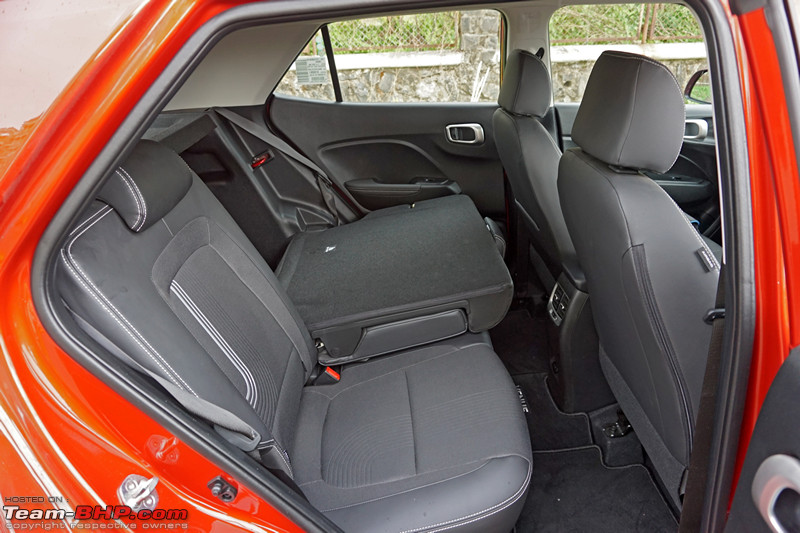 SX variant, however, does not get a split folding rear seat:  Folding the seatbacks down gives you much larger cargo capacity. However, the Venue doesn't come with an adjustable boot floor and you cannot get a flat loading bay:  Top tether for the child seat (there's one on each side of the rear seat):  High loading lip means you have to make an effort to put your bags in or take them out:  Only the lower part of the tailgate is cladded on the inside. Still, there are no ugly bits sticking out anywhere. All the wiring is properly concealed, including the demister's:  A tailgate emergency opener has been provided at its base: 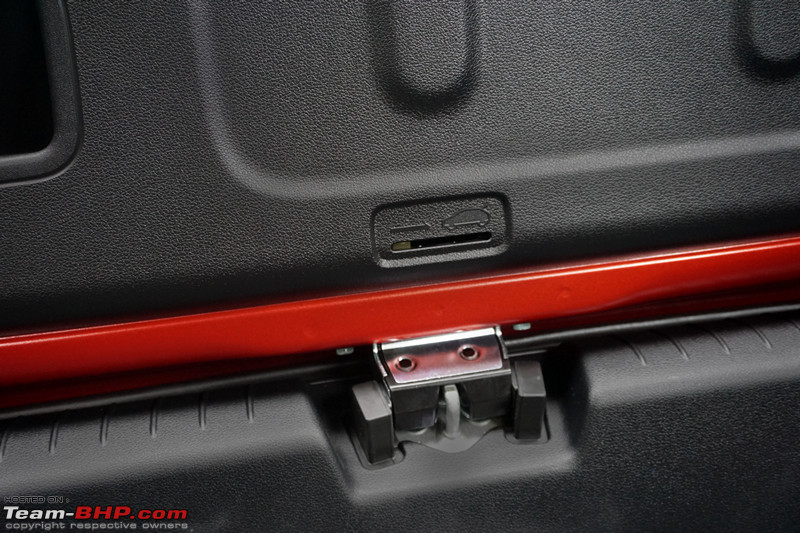 Sturdy handle to pull the tailgate down. IMHO, the orientation of this handle is wrong. Try using it while facing the boot (like you ideally would). I much rather prefer one like the XUV300's (reference image):  Gap at the base of the boot lip to put your fingers in and lift the floor up:  Tools are housed in a soft bag, which sits in the spare wheel:  Spare wheel in all trim levels is a 15-inch steel unit with 195/65 section Apollo Alnac 4G rubber. The higher variants should definitely have gotten a spare of the same size as the regular wheels. When using a thinner space saver, remember to drive very cautiously (due to the varying tyre sizes). The bean counters surely have more influence at Hyundai than they did 5 years ago:  Toolkit has the regular tyre changing equipment:  Last edited by GTO : 19th September 2019 at 10:55. |
| |  (35)
Thanks (35)
Thanks
 |
| The following 35 BHPians Thank Aditya for this useful post: | akshay81, ashking101, ChiragM, CrAzY dRiVeR, dailydriver, darklord, Gaboonviper04, Gannu_1, GTO, hemanth.anand, InControl, jailbird_fynix, jithin23, JoseVijay, lemedico, MDED, MSAneesh, N33raj, paragsachania, phoenixash, RaghuVis, RavenAvi, rohitlp, samabhi, Samba, SanSabh, Sheel, Simat, SS-Traveller, sukiwa, theexperthand, The_Outsider!, uday.ere, vaasu, vb-saan |
| | #6 |
| Team-BHP Support  | In-Car Entertainment The SX DCT and SX(O) variants of the Hyundai Venue get an 8-inch touchscreen AVNT infotainment head-unit with 6 speakers (including 2 tweeters). Connectivity is through Bluetooth, USB and AUX. Apple CarPlay and Android Auto are supported as well. Video playback is through USB. The system also comes with navigation and voice recognition & serves as a screen for the reversing camera. Further, it has Blue Link connectivity which has 33 features, out of which 10 are India specific. The touchscreen has no lag and the visibility is satisfactory, even under direct sunlight. Screen resolution and clarity are impressive. Physical buttons have been provided as well for those who prefer using them over a touch interface (these are better to use on the move). 8-inch floating head-unit sticks out of the dashboard. The symmetry of the cabin is broken by the different sized buttons of the infotainment system. The mode knob on the left is only half the size of the power knob on the right side. The system is easy to operate: 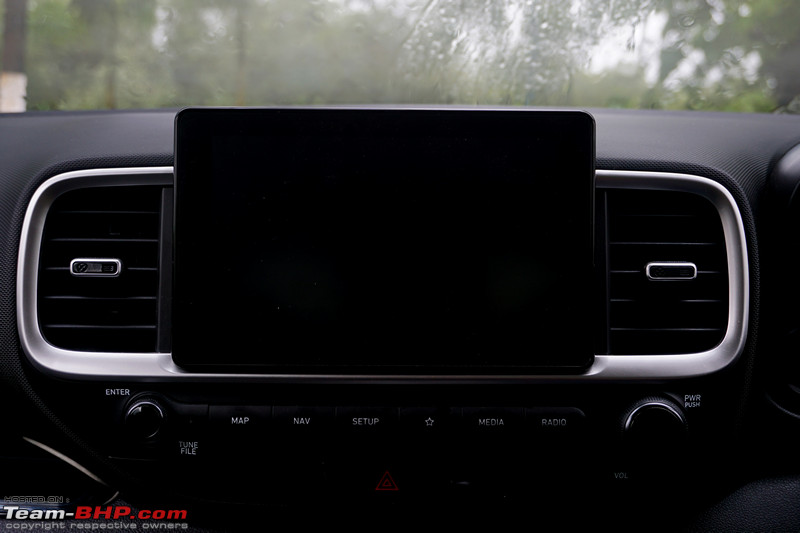 Here's a look at how it sticks out of the dashboard. Mercedes started this trend and now everyone else is on it. We don't like the trend at all - looks so aftermarket too:  Music is played through 6 speakers – one on each door…  …and a tweeter on each of the front doors. I found the sound quality to be "good" for an OEM system (Nexon is better):  You can have a split screen to display both - the map as well as the media being played:  A variety of settings can be altered to suit the owner's preferences. Additionally, the display can be switched off (for night driving). To bring it back to life, simply touch the screen anywhere:  "Arkamys sound mood" provides a quick way to get different feels. It has 4 settings - natural, club, lounge and live. Or you could just set the tri-band equalizer (our choice):  Navigation and other functions can be given priority over music:  Some more useful settings:  Illumination preferences with individual day / night settings too:  One can adjust the display brightness in each of these modes:  The infotainment system offers support for Android Auto and Apple CarPlay. For running any of these features, your smartphone must be connected to the system via a USB cable: 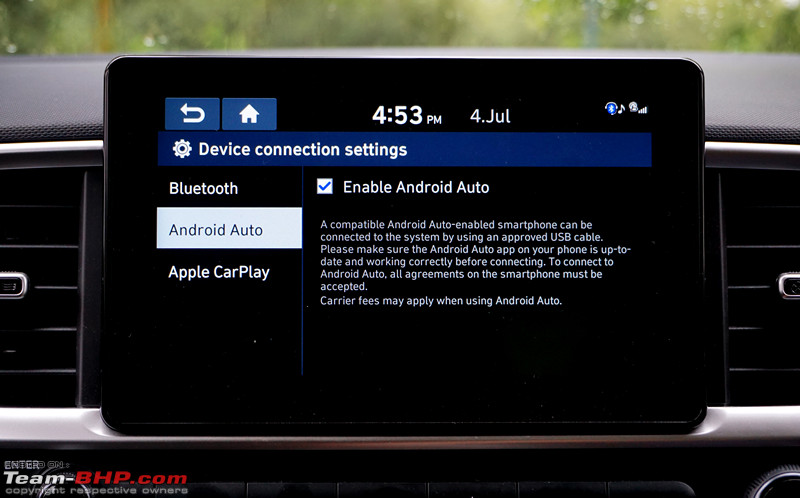 You can pick a QWERTY keyboard...  …and choose between the screensavers:  We couldn't test the phone. Reason? In what is extremely rare for a Hyundai, our test car had a bug!!! The mic of this car was not working either for voice commands or phone calls (yes, we tried with different phones):  Text messages can be read out:  Auto replies can be set: 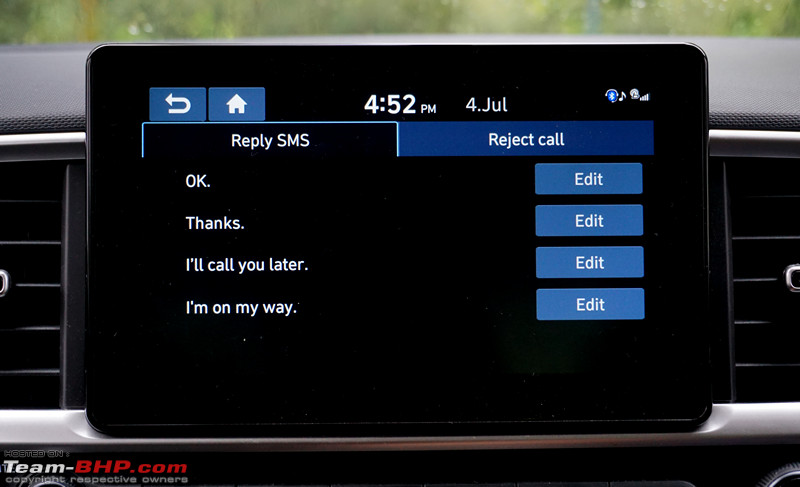 Messages can also be set to be sent upon rejecting a call: 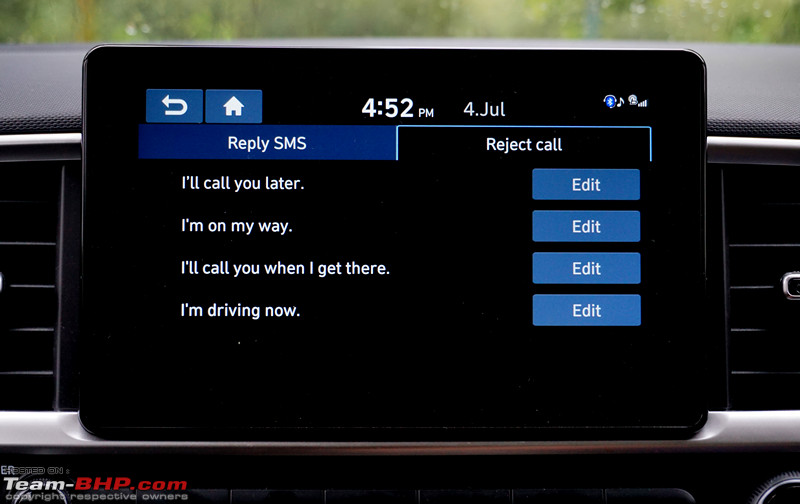 Navigation can be switched to full screen mode as well. The voice is easy to understand. With Google Maps available via Android Auto & Apple CarPlay, we doubt anyone's going to use the inbuilt navigation though:  The speed limit of the road is also displayed. When you cross it, a beep sounds periodically (you can disable this). Other rules such as no parking or no overtaking are also shown. Smart!  SD Card slot is only for maps (provided by MapMyIndia). They are extremely accurate; worked well even when the car was taken to some rural areas:  The various functions of the navigation system. Don't miss the customisable shortcuts at the bottom, starting with home & office:  Like most GPS systems, a list of POIs is available including Hyundai dealerships & workshops nearby:  You can add apps in your preferred sequence to the menu, or remove them: 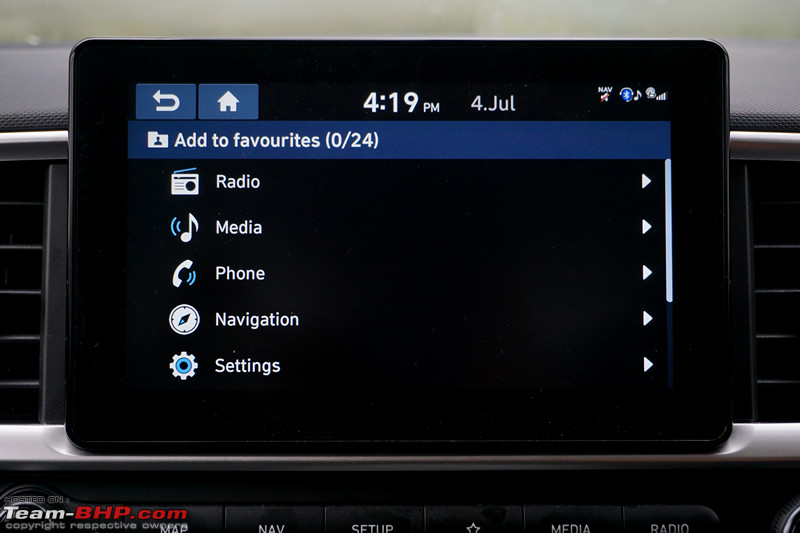  You can replace or move the homescreen widgets...  ....or change the order of the icons: 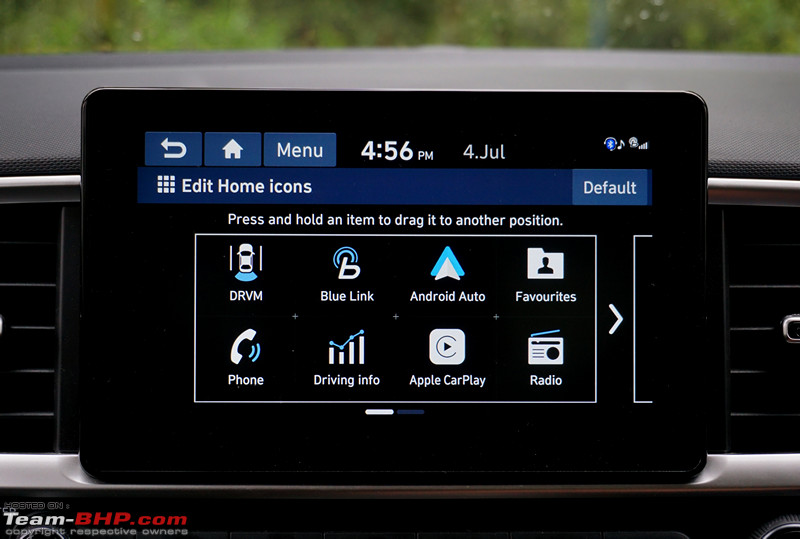 A summary of the driving information is displayed: 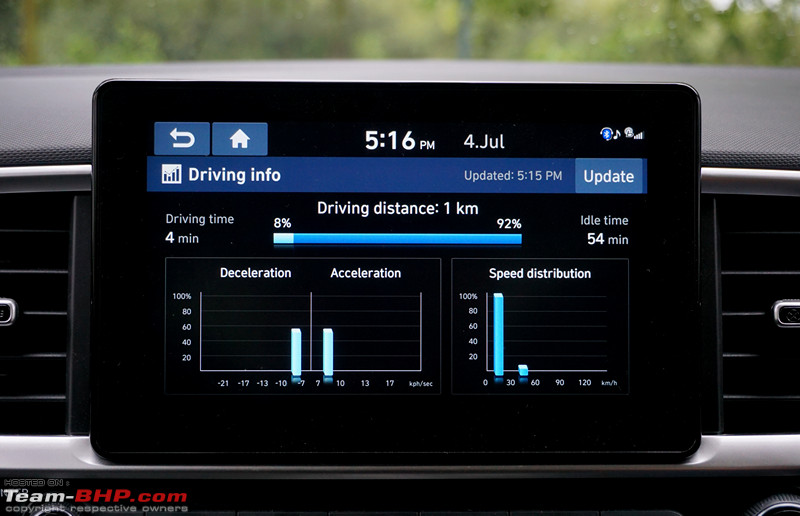 The system supports Android Auto and Apple CarPlay. You can get directions, make calls, send and receive messages and listen to music through the Android interface:  Navigation through Google Maps is obviously superb. Android Auto helps in getting real-time traffic updates (via Google) on the screen:  Apple CarPlay has been provided for the iOS fans:  Touchscreen doubles up as a display for the rear view camera and features adaptive guidelines which indicate the path that the car is going to take (based on steering input). As we have seen earlier, there are 2 rear parking sensors provided on the car. The camera has a nice wide angle, while the display quality is fair (our segment-benchmark remains the EcoSport & its awesome screen quality):  Camera quality in dark surroundings is surprisingly poor. Where is Hyundai's famed attention-to-detail?  Owners can download the Hyundai iBlue Remote App on their smartphones, connect it to the infotainment system via Bluetooth and use their phones as a remote control. You can select the music source, adjust the volume, equalizer & more. Might be useful for chauffeured owners, or if your kids on the backseat are controlling the music:  Full connection and control guides have been provided. Switch the audio system on or off and mute/unmute the system with this app. Pretty much all the controls are here:  Last edited by GTO : 19th September 2019 at 10:55. |
| |  (29)
Thanks (29)
Thanks
 |
| The following 29 BHPians Thank Aditya for this useful post: | AjinkyaP, akshay81, ashking101, Bee, ChiragM, CrAzY dRiVeR, dailydriver, darklord, Gaboonviper04, Gannu_1, GTO, hemanth.anand, InControl, JoseVijay, MDED, MSAneesh, N33raj, phoenixash, RavenAvi, Samba, SanSabh, Sheel, Simat, SS-Traveller, theexperthand, The_Outsider!, Turbanator, uday.ere, vb-saan |
| | #7 |
| Team-BHP Support  | Blue Link The Hyundai Venue comes with "Hyundai Blue Link", which has an in-built device powered by a Vodafone-Idea eSIM and a Cloud-based Voice Recognition platform from Sound Hound - an Artificial Intelligence (AI) company. Blue Link has been introduced in the Indian market with 33 features (10 are India specific) for connectivity with Safety, Security, Remote operations, Geographic Information Services, Vehicle Relation Management, Artificial Intelligence, Alert Services and Location Based Services. Blue Link services will be complimentary for the first 3 years, post which owners can renew them for a fee. For all Hyundai Venue customers, a Blue Care home visit will be scheduled on the 15th day of the purchase of the vehicle. This is a courtesy visit, which owners can use to understand features better or clear up any doubts on the car. By pressing the rightmost button on the IRVM, you can start the Blue Link system (it's also there in the ICE). Among other things, you can access the "push map by call center" feature in which the Hyundai call center will ask you for your destination, then set a map on the head-unit: 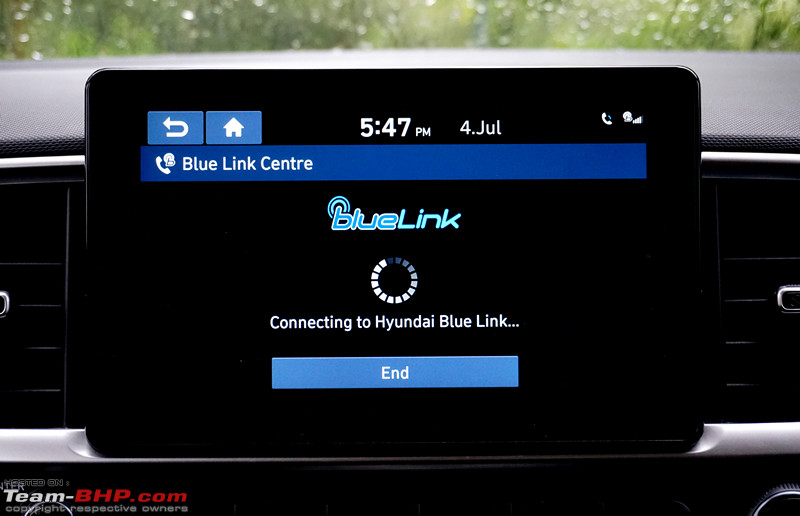 If your car suffers a breakdown, pressing the middle button on the IRVM (with the towing van icon) notifies the Blue Link connect center, which will get in touch with you and dispatch assistance to help you out. Nifty for breakdown, accident, tyre / key / battery / fuel trouble:  Emergency assistance has been provided as well. Most useful for accidents. On pressing the SOS button on the IRVM, the Blue Link connect center will inform emergency services to send assistance (police / ambulance) to your location: 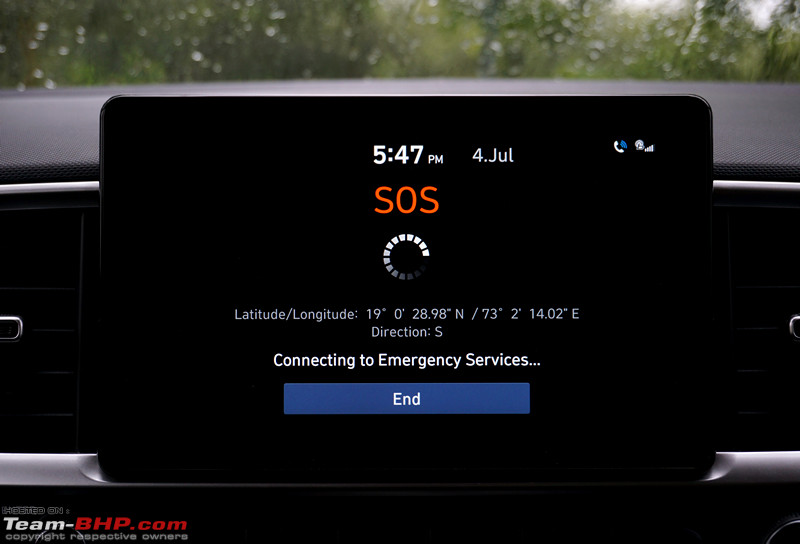 The car and your smartphone will be connected to each other through a cloud-based network. You need to download the smartphone app (available for IOS and Android, both) and set up the system:   You can use the app to track your vehicle in real time, share your vehicle's location with your friends through Facebook Messenger / WhatsApp, remotely start or stop the car's engine and the climate control system, lock or unlock the vehicle, flash the headlamps and have the horn blow for 30 seconds (to locate the car), view the status of the doors, lights etc., locate the car on maps, share 7 partial Blue Link services with 5 people, get a vehicle health report, view trip logs and set destinations for various dates. One can track the car when given to a valet through the "Valet Alert" feature, set boundaries through the Geo Fence Alert feature, set a speed alert, a time fence alert and an idle alert (e.g. if your chauffeur is idling it for too long). A maintenance alert and monthly health report are also provided. An alert is flashed on your smartphone if someone attempts to steal the car. If the car is stolen, you can track it, or have it immobilised through Blue Link. The "auto crash notification" works when the vehicles airbags are deployed after a crash. An automatic call is made to the connect center, which then sends emergency services to assist you. Do note that the remote engine start feature is available only for the DCT variant. The car can be remotely started ONLY if the doors, bonnet and boot are properly locked and the gear shifter is in the "P" position: 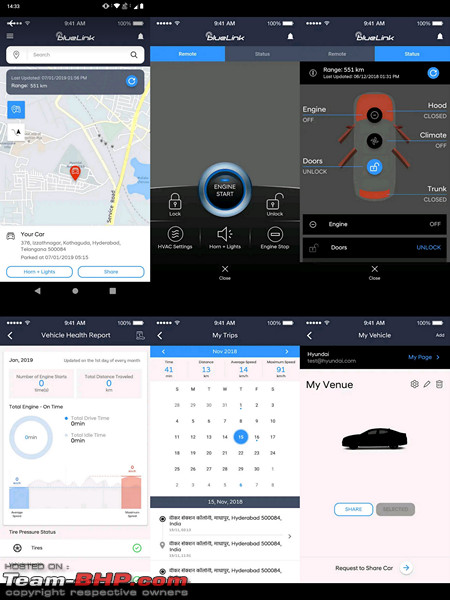 Blue Link can be used to send a destination to the car's navigation system:  Once the destination is set on the navigation system...  ...you can share your destination by sending a link through SMS... 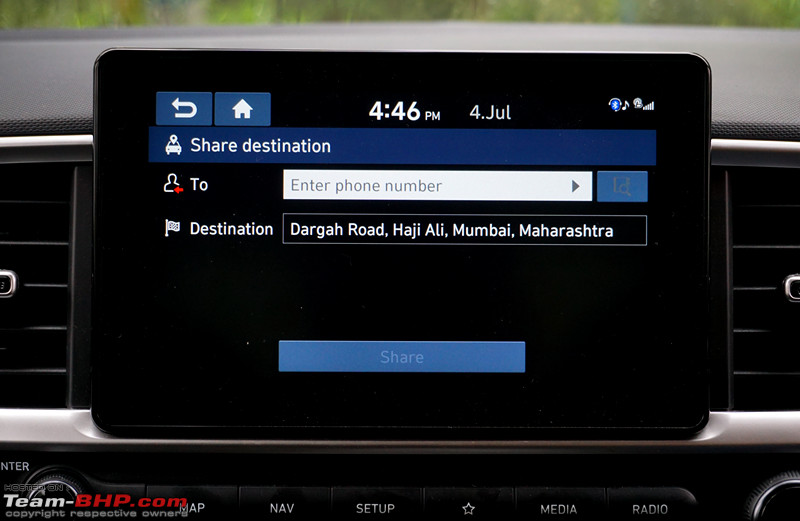 ...and get real time status of the traffic along various routes:  A check of the vehicle's health can be carried out. If any issues are found, they will be displayed on the screen: 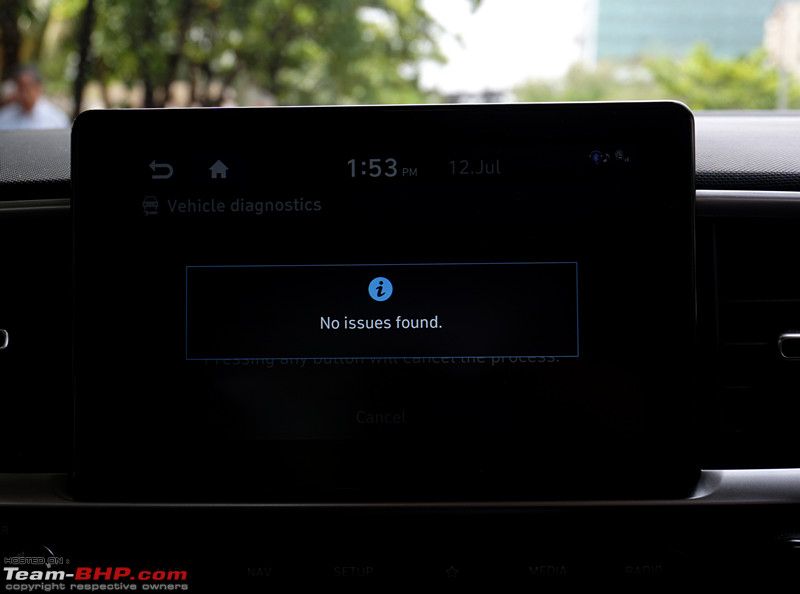 Last edited by GTO : 19th September 2019 at 10:54. |
| |  (25)
Thanks (25)
Thanks
 |
| The following 25 BHPians Thank Aditya for this useful post: | Abhinav V, akshay81, ashking101, ChiragM, CrAzY dRiVeR, dailydriver, darklord, Gannu_1, GTO, hemanth.anand, InControl, JoseVijay, MSAneesh, N33raj, phoenixash, RavenAvi, rohitlp, Samba, SanSabh, Sheel, Simat, theexperthand, The_Outsider!, uday.ere, vb-saan |
| | #8 |
| Team-BHP Support  | Driving the 1.4L Diesel MT 1.4L, 4-cylinder CRDi diesel fills the engine bay fairly well:  To power the Venue, Hyundai has used the familiar 1.4L, 4-cylinder 16V CRDi diesel engine that does duty in the Elite i20, Verna and Creta. Just like it does in the other cars, the motor produces 89 BHP (@ 4,000 rpm) & 220 Nm of torque (@ 1,500 - 2,750 rpm) and is mated to a 6-speed manual transmission. This makes it the least powerful car in the segment in terms of BHP. Even in terms of torque, it is outclassed by the XUV300 (300 Nm) and Nexon (260 Nm). However, the Venue is lighter than all its direct rivals, so it fights back in the power-to-weight figures. With a kerb weight of 1,160 kg, the Venue diesel has a power-to-weight ratio of 77 BHP / ton, which is lower than most of its rivals. It is beaten by the Mahindra XUV300 (85 BHP / ton), Honda WR-V (85 BHP / ton), Tata Nexon (83 BHP / ton) and Ford EcoSport (80 BHP / ton). However, the Venue's torque-to-weight ratio of 190 Nm / ton is higher than most cars in its segment. But it is overshadowed by the XUV300 (221 Nm / ton) and Tata Nexon (199 Nm / ton). While outright performance is more than sufficient, the Venue doesn't have the legs of the XUV300, EcoSport or Nexon on the open road. To start the Venue diesel, simply press the clutch pedal and tap that engine start button. You’ll immediately notice the smooth idle. Get moving and the diesel feels extremely refined. If you've been in a Creta, I can tell you that refinement levels are about the same. In this department, the Venue is among the best in class. The fair driveability is immediately evident. Turbo-lag is there but minimal, resulting in far lesser gear shifts around town. The power delivery feels quite linear. This 1.4L diesel is city-friendly and is a breeze to drive in traffic conditions. There is adequate torque delivery even before the turbo spools up, and the motor certainly doesn't feel dead between 1,300 - 1,500 rpm (unlike some of its rivals). In some low rpm situations, the Venue feels quite lively. It manages to pull from as low as 5 km/h in 2nd gear. However, you need to slip the clutch a bit to make the Venue clear the 2nd-gear speed breaker test. That absolute bottom end is not there. The turbo is spooling fast at ~1,800 rpm and the Venue feels very sprightly at medium city speeds. Hyundai engineers have done a good job of tuning the diesel. The car can cruise at 40 km/h in 3rd gear with the engine spinning @ 1,600 rpm, without feeling lugged. The diesel feels at home in the city as well as on the highway. Keep the motor on the boil and it will deliver satisfactory open-road performance. The throttle feels eager to respond as well. There is no push-into-the-seat feeling though, as power is delivered in a more linear fashion. Out on the expressway at speeds, the car is a capable long distance cruiser. The 220 Nm of torque ensures that overtaking manoeuvres are nicely executed. At times, I didn't even shift down from 5th / 6th gear when passing others from the fast lane. A gentle nudge on the accelerator does the trick. The Venue diesel can comfortably maintain 3 digit speeds all day. That additional ratio on the 6-speed box allows a superior spread of power and the gear ratios are perfectly chosen. Additionally, the 6th gear brings relaxed cruising ability. The Venue sees 100 km/h at merely ~1,800 rpm and 120 km/h at 2,200 rpm. The engine has a very enjoyable mid-range. The unit revvs clean till 5,100 rpm, but as is the case with most diesels, there is no point in going so high on the gauge. Though it revvs clean till the redline, there's not much after 4,500 rpm. It runs out of breath then. That said, the fact that it revvs clean and goes higher, will definitely help while overtaking. The SX(O) is equipped with 'hill-start assist'. The feature works just as it should, without any driver intervention (completely in the background). Stop on an incline, the car will hold itself in place for almost 3 seconds, giving you enough time to get your foot off the brake pedal and onto the accelerator. No roll-back worries. We drove the Venue on some inclines and it was a fuss-free experience. Newbies will appreciate this feature as they usually struggle with the handbrake + pedals co-ordination on climbs. The 6-speed gearbox is smooth to operate with a light shift action, short throws and well-defined gates. The clutch is not a super light unit, but neither is it heavy. The pedal does have a long travel range though, longer than you'd expect in a monocoque crossover. However, despite being stuck in traffic for 1 hour, the clutch pedal did not bother us. Coming to NVH levels, this 1.4L engine is easily the most refined amongst oil-burners. It never sounds too gruff or too loud. In fact, when cruising on the highway, it doesn't sound like a diesel at all. Take the engine above 3,000 rpm & things get audible, yet it's far from disturbing. It gets boomy only at the absolute redline. Other than that, the engine is sweet and smooth. On idle, you feel a slight buzz on the steering wheel, pedals and gear lever, but there are no noticeable vibrations. Mild cabin shake can be felt on switching the engine off, but that's nothing to really complain about. Like most Hyundais, the insulation in the Venue is brilliant. Road noise is within acceptable limits, and so is the wind noise. The ARAI-certified fuel economy of the Venue diesel is 23.7 km/l, which falls just short of the Vitara Brezza’s 24.3 km/l, but is ~2 km/l behind the 25.5 km/l benchmark set by the WR-V. Still, we doubt anyone will complain about the Venue's FE as it is respectable in its own right. Tried & tested 1,396 cc diesel engine develops 89 BHP & 220 Nm: 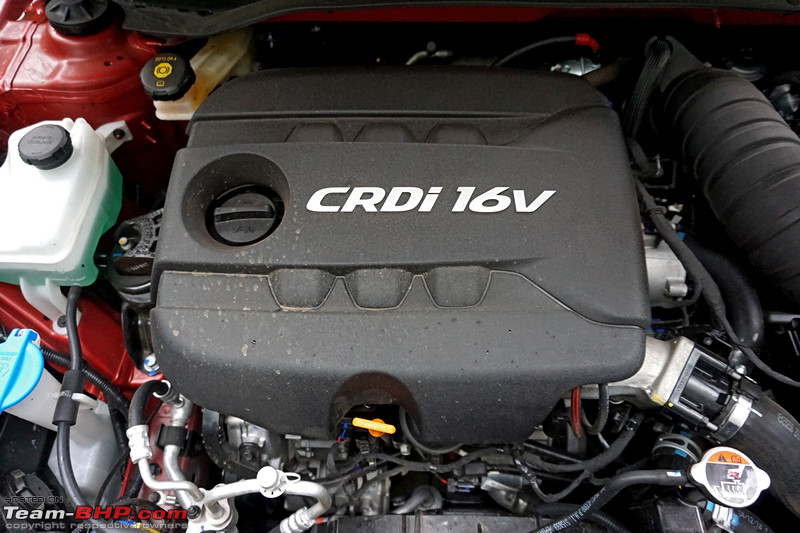 No cladding under the bonnet for the diesel. While the refinement levels are still top notch, this comes as a surprise because the cheaper Grand i10 gets an insulation sheet!  While underbody protection has been provided, it does not stretch back a long way. Still, the critical components appear to be protected:  Turbocharger sits behind the engine, just ahead of the firewall: 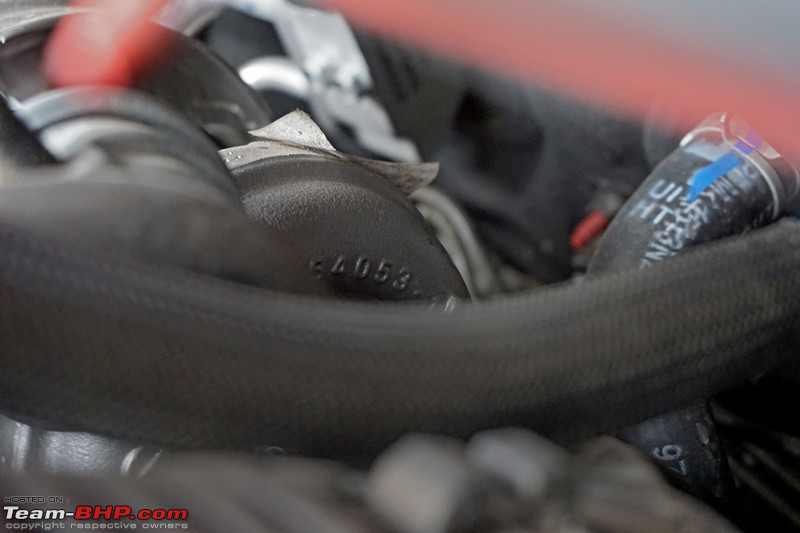 Firewall insulation is sufficient:  Fusebox has more empty slots than filled ones!  Underside of the cover contains a diagram of the fusebox, extra fuses and a tweezer:  Vertically-stacked intercooler is on the left side of the engine bay:  Smooth & sweet 6-speed MT lever is shared with other Hyundai cars. Reverse is located up, to the extreme left:  Gear knob is leather-wrapped and has silver highlights, while the lever gets a leather boot:  To engage reverse, silver button has to be pulled upwards:  MID has a gearshift indicator. Newbies will appreciate. It shows which gear you should shift to in order to obtain the best fuel economy. As an example, if you are in 4th and revving hard, it will tell you to shift straight to 6th!  Last edited by GTO : 19th September 2019 at 10:53. |
| |  (27)
Thanks (27)
Thanks
 |
| The following 27 BHPians Thank Aditya for this useful post: | Added_flavor, akshay81, ashking101, ChiragM, CrAzY dRiVeR, dailydriver, darklord, Gannu_1, GTO, hemanth.anand, InControl, jithin23, JoseVijay, MSAneesh, N33raj, paragsachania, phoenixash, Ponbaarathi, RavenAvi, Samba, Sheel, Simat, sukiwa, The_Outsider!, uday.ere, vaasu, vb-saan |
| | #9 |
| Team-BHP Support  | Driving the 1.0L Petrol MT Turbo GDI engine gets a host of technical innovations. It's quite a compact motor, with the exhaust manifold integrated into the block:  The Venue petrol is powered by Hyundai’s in-house developed 998cc, 3-cylinder turbocharged engine. It's called the Kappa 1.0 Turbo GDI, and gets a direct injection fueling system, electronic waste gate actuator, a variable oil pump, oil spray jets for the pistons from the crank side and dual variable valve timing. The other 3-cylinder 1.0L turbo-petrols we've driven in India are the EcoSport (EcoBoost) & Baleno (BoosterJet). I'm pretty sure we'll be seeing this turbo-petrol in other Hyundai cars. The 1.0L petrol produces a strong 118 BHP (@ 6,000 rpm) and 172 Nm (1,500 - 4,000 rpm). While the power figure puts it just behind the EcoSport’s segment-leading 121 BHP (1.5L) & 123 BHP (1.0L EcoBoost), the torque rating puts it ahead of most of its direct rivals. It is, however, noticeably lesser than the XUV300's class-leading 200 Nm. With a kerb weight of 1,095 kg, the Venue is the lightest monocoque sub-4 meter SUV in India. It has a power-to-weight ratio of 108 BHP / ton and torque-to-weight ratio of 157 Nm / ton. These figures put the Venue comfortably ahead of all its rivals. As you might have guessed by now, there is more than enough performance available to keep drivers happy. To start the engine, you need to press the clutch and then hit the engine start button. Despite it being a 3-cylinder, very few vibrations come into the cabin (although there is mild cabin shake when cranking). At idle, you can barely hear the engine and there are no vibrations felt anywhere. Even on the move, the refinement is certainly impressive! Not many will be able to tell that the engine is missing a cylinder. Hyundai's NVH engineers are indeed the best in the business. The Venue moves off from a standstill in a clean manner. Despite the turbocharger + small engine size, driveability is good and power delivery feels linear. We thought that like the EcoSport, the turbo petrol will be dead & laggy, but we were able to pull from even 1,100 rpm in 2nd gear. Some lag is there of course, yet it's minimal & well-controlled. That said, you have to be a little patient when pulling from low rpms in 2nd gear. While you won’t need to downshift much in the city, you are likely to feel the turbo lag in certain situations, say on an incline or if you need to suddenly close a gap in traffic. Still, we won’t call it bad at all. The engine starts coming into its stride above ~1,500 rpm. Around town, it can cruise at 40 km/h in 3rd gear with the engine spinning at 1,700 rpm, sans any fuss. As the revvs cross 2,000 rpm, the 1.0L engine comes into its power band. On the open road, you'll enjoy the punch of the turbocharged petrol. Its mid-range, in particular, is fun. Throttle response is not the sharpest, but it's fair. The Venue can make good progress on the open road. Keep the revvs high, work the engine and she transforms into a quick expressway cruiser. The engine revvs till 6,600 rpm, which we found to be a little low for a petrol (the fuel supply cuts off abruptly at 6,600 rpm). This rev limit can sometimes catch you out in the middle of an overtaking maneuver. Overall driveability is good and you won't find the need to downshift often, although there is some lag in the higher gears. So, while passing slow moving vehicles on undivided highways, it is better to downshift, use the mid-range and fly past them. In 6th gear, the car can cruise at 100 km/h & 120 km/h at 2,100 rpm & 2,600 rpm respectively. These are nice numbers for a small petrol motor. All in all, this 1.0L would be my pick over Hyundai's 1.2L Kappa engine. Just like the diesel, the petrol SX(O) is equipped with 'hill-start assist'. The feature works just as it should, without any driver intervention (completely in the background). Stop on an incline, the car will hold itself in place for almost 3 seconds, giving you enough time to get your foot off the brake pedal and onto the accelerator. No roll-back worries. Newbies will appreciate this feature as they usually struggle with the handbrake + pedals co-ordination on climbs. The 6-speed gearbox is light, smooth & sure-slotting, with short throws too. While the clutch is light enough (but not super light), we found its travel range to be on the longer side. Coming to NVH levels, the Venue does very well at slow speeds and around town. On revving, you can hear that familiar 3-cylinder thrum though. While this noise is there, it is not excessive. There’s almost no engine sound heard in the cabin if you're driving in a calm manner. Even while cruising on the highway, the engine is silent enough. What we appreciated is that the motor actually sounds nice when revved hard. Enthusiasts will like. Around 3,500 rpm, the engine gets audible, and l-o-u-d above 6,000 rpm. Wind noise is minimal at 100 km/h, while road and tyre noise are par for the course. In terms of fuel economy, the Venue carries an ARAI rating of 18.27 km/l, which is the best in the segment. However, in the real world, expect city FE of 12 - 13 km/l from this turbo-petrol. 998cc turbo-petrol engine develops 118 BHP & 172 Nm:  Just like the diesel, no insulation sheet under the bonnet of the petrol. This one doesn't need it:  1.0L turbo petrol is an easy fit in the bay:  Here too, the underbody protection does not stretch back a long way. Still, all the critical components appear to be protected:  Firewall insulation is identical to the diesel's. Overall NVH is top class!  Again, like the diesel, there is a vertically-stacked intercooler:  6-speed shifter is smooth to use:  Turbo-petrol gets a lovely red badge on the tailgate:  Last edited by GTO : 19th September 2019 at 10:52. |
| |  (38)
Thanks (38)
Thanks
 |
| The following 38 BHPians Thank Aditya for this useful post: | Added_flavor, akshay81, ashking101, Bee, ChiragM, CrAzY dRiVeR, dailydriver, frankmehta, Gannu_1, GTO, heavenlybull, hemanth.anand, InControl, itsashishsharma, jithin23, JoseVijay, Kashish, MDED, MSAneesh, N33raj, paragsachania, phoenixash, Punatic, RavenAvi, Reinhard, Samba, SanSabh, Simat, sukiwa, Swap_Abarth, The_Outsider!, uday.ere, vaasu, vaish9925, Varun_HexaGuy, vb-saan, Venkatesh, VTec_KickedInYo |
| | #10 |
| Team-BHP Support  | Driving the 1.0L Petrol AT Hyundai is offering a 7-speed DCT as an option with the Venue 1.0L petrol. The company has always been big on automatic gearboxes in India (right from the original Santro), and this is their first dual-clutch AT here. The DCT is available only in the SX+ (one level below the top-end) and S (mid) trim levels. Both are equipped with hill-start assist, vehicle stability management and electronic stability control. According to Hyundai, 35% of the initial 50,000 bookings were placed for the DCT variants. India clearly loves its slushboxes now! The Venue AT is the only car in the segment with a DCT. All its rivals come with either an AMT or a torque converter. 7 ratios also result in a superior spread of gearing and the transmission does feel decidedly superior to its rivals. However, there are no paddle shifters or even a sport mode, clearly telling you this isn't an automatic for enthusiasts. A silly move - at least a "sport" mode would have helped on highways & mountain roads by keeping the engine on the boil. That said, the DCT gearbox is smooth and the entire package is very refined. The Venue DCT costs between Rs. 9.35 - 11.11 lakhs (ex-showroom, Delhi). At this price, it undercuts the EcoSport. The Nexon, however, is priced lower due to the use of the cheaper AMT. Like the MT, the Venue DCT is very refined at idle. It moves off seamlessly from a standstill. There is a slight initial lag though, as there is no torque-converter & the turbo-charger. Once you're moving, light accelerator input is all you'll need to commute in the city. The gearbox moves up early, while shifts are quick and smooth. Driving with a light foot, you'll never even know that the gears are being changed. They are almost imperceptible. The turbo-petrol offers brisk acceleration, while the power & torque on tap make the gearbox's job easier. We also liked how the gearbox is never found hunting for gears. Combine this smooth AT with the light steering, excellent ergonomics, properly placed dead pedal & clean frontal visibility and you have a sweet city ride. For bumper to bumper traffic conditions, there is a fair amount of 'crawl' available too. Just lift your foot off the brake pedal in 'D' and the Venue will crawl forward, allowing you to drive in bad traffic with just one pedal (the brake). Downside? The Venue is reluctant to downshift from 2nd -> 1st. Hence, you'll need to be patient if you want to suddenly close a gap in traffic (as an example). Thanks to the powerful engine, the Venue AT is a competent expressway cruiser too. You can easily hit silly speeds and like in the MT, the mid-range is punchy. It sure comes in handy for overtaking. For long distance cruisers, the engine spins @ 2,600 rpm at 120 km/h (100 km/h = ~2,100 rpm). Kickdown response time is average. If the revvs are low, it takes a second or so for the gearbox + turbo to react. Sometimes, you'll find the gearbox to be hesitant to downshift too. But once the AT & turbo respond, this thing is very peppy. Will add that, when the engine is in the meat of the powerband, the reaction times are far lesser. The Venue's 7-speed DCT shifts faster than the gearboxes used by its rivals. It's clearly the best AT among the Compact SUVs. Just wish Hyundai had given it a proper "sport" mode for the times when you're in the mood for fun. That's a major omission from Hyundai. Paddle shifters will be missed by owners too, yet we would've forgiven this if sport mode was provided. Manual mode is useful when you want to prepare the car for overtaking a fast vehicle on a 2-lane highway, or when you desire engine braking. Move the gear lever to the right to engage manual mode. The response time to your commands is quick. What we found disappointing was that, even in manual mode, you can take the revvs to just ~6,500 rpm (which is the start of the redline) before the transmission shifts up on its own. Keep in mind that it's tuned very conservatively & won't allow aggressive downshifts if the rpm level is even a little high. The Venue turbo petrol DCT has an ARAI-certified fuel economy figure of 18.15 km/l, which is higher than the two other automatics available in the segment i.e. the Ford EcoSport and Tata Nexon. Owners are reporting 9 - 10 km/l in the city (a handful did say 8.5 too), and 14 - 15 km/l on the highway. We'll keep our fingers crossed on the long-term durability of this gearbox. While it's reassuring to have a manufacturer with a track record for reliability backing it, the fact is that no dual-clutch gearbox has had a clean reputation in India. Not Ford's DCT, and certainly not VW's DSG. We'll be keeping a keen eye on reports from Venue owners. Be sure to take that extended warranty package! Venue turbo petrol gets a 7-speed DCT. Gear lever comes with a glossy black top, silver highlights and a leather boot. Looks smart. To engage manual mode, move the lever to the right. Push the lever up to upshift and down to downshift (just the way we prefer it):  Unlock button is conveniently placed & looks stylish too:  The shift lock release button. Pressing this button bypasses the gear lock system whereby you cannot move out of position "P" unless the key is inserted and the brake pedal is pressed. Use the shift lock button when you park on an incline and can’t move the lever out of "P". The feature could also be used in a breakdown (for towing):  Dual-clutch ATs are more prone to overheating. In the Venue, the MID has a digital temperature gauge for the transmission:  DCT badge on the front-right body panel is the only indicator of the transmission used by the car: 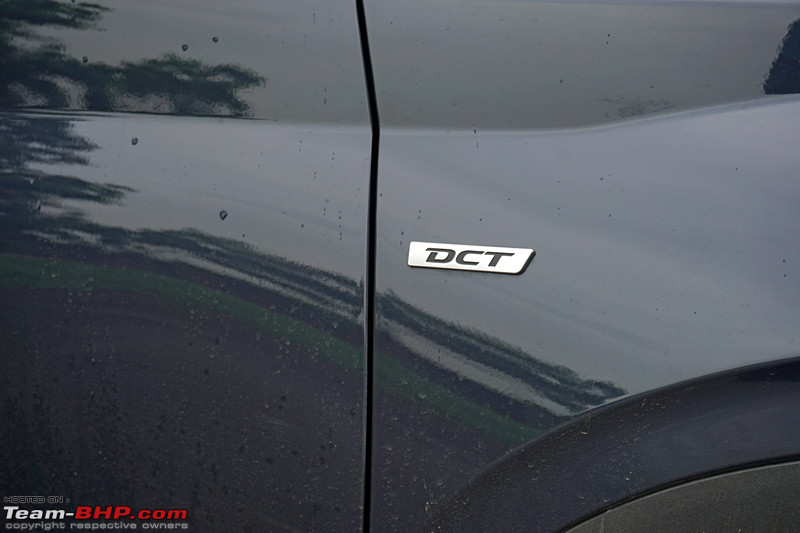 Last edited by GTO : 19th September 2019 at 10:51. |
| |  (38)
Thanks (38)
Thanks
 |
| The following 38 BHPians Thank Aditya for this useful post: | Added_flavor, AjinkyaP, akshay81, ashking101, ChiragM, contentedbloke, CrAzY dRiVeR, dailydriver, drrajasaravanan, espraveen, Gannu_1, gauravanekar, GTO, hemanth.anand, HMV, InControl, itsashishsharma, jailbird_fynix, jithin23, JoseVijay, MSAneesh, N33raj, PapaKiloSierra9, paragsachania, phoenixash, RavenAvi, sainyamk95, samabhi, Samba, SanSabh, Simat, SS-Traveller, sukiwa, The_Outsider!, uday.ere, vaish9925, vb-saan, VTec_KickedInYo |
| | #11 |
| Team-BHP Support  | Ride & Handling The Venue uses a McPherson strut suspension with coil springs at the front and a coupled torsion beam at the rear. Low speed ride quality is compliant & mature, with small bumps being absorbed well. However, there is a bit of a firm edge to the ride which you will feel on bad roads & large potholes. This is inevitable with most crossovers as manufacturers have to firm things up a bit due to the raised height. Even medium-sized potholes make their presence felt inside. Still, owners won't complain as the ride is compliant overall. At the rear too, it doesn’t get too bouncy. That said, things aren't as plush as in the Honda WR-V. The car feels quite comfortable on the expressway. While our test cars were equipped with 16" wheels, lesser variants get 15" rims with taller rubber. The ride quality on those is likely to be cushier. The suspension does its work silently as well. As expected of a monocoque crossover, the Venue is very car-like to drive. Owners will appreciate this in the city & on highway drives alike. Out on the open road, straight line stability is good. While the car doesn’t feel twitchy, it has a tendency to wallow over expressway bumps & undulations. It is certainly not as planted as the segment-leading Ford EcoSport at high speeds. In terms of handling, the Venue remains composed through fast corners. There is some body roll, yet it's controlled. The car feels sorted, even when being pushed through the twisties. It behaves just like you'd expect a family crossover to. The dynamics are clean with no nasty surprises at all. That said, once again, the EcoSport remains the segment leader in this department. Important to note that the SX(O) and DCT variants are equipped with electronic stability control (ESC), vehicle stability management (VSM) and hill assist control (HAC). The grip provided by the Venue's 215/60 MRF Wanderer tyres was acceptable, but not exceptional. Enthusiasts with a more aggressive driving style will want to upgrade to stickier rubber. Drive to your friendly tyre shop straight from the showroom itself to get the best exchange price. The electric power steering is light and butter-smooth at parking / city speeds. Along with its small size, this makes for a very easy car to drive in urban conditions. It's turning radius of 5.1m is as small as the segment-best Tata Nexon. On the highway, the steering is not nervous. Those days of crazy Hyundai steerings are gone. The steering weighs up alright and it's not overtly sensitive either. No owner will complain. However, enthusiasts aren't likely to find its feel & feedback to their tastes. The unladen ground clearance is rated at almost 200 mm (we've heard 190 - 195 mm from different Hyundai people, but it's not put on paper). Suffice to say, the GC is more than enough. All variants of the Venue come with disc brakes at the front and drums at the rear, with ABS + EBD. The brakes perform as expected. The car stops in a straight line sans drama when braking from high speeds. However, the brakes do feel over-servoed. At lower speeds, just tap them and the car stops on a dime. They sure take some getting used to. It reminds us of how the 1st-gen Honda City Vtec's brakes were. McPherson strut suspension with coil springs at the front:  Rear suspension is a coupled torsion beam setup:  Last edited by GTO : 19th September 2019 at 10:50. |
| |  (39)
Thanks (39)
Thanks
 |
| The following 39 BHPians Thank Aditya for this useful post: | AjinkyaP, akshay81, AutoIndian, Bee, ChiragM, CrAzY dRiVeR, dailydriver, frankmehta, Gannu_1, gauravanekar, GTO, hdman, hemanth.anand, InControl, itsashishsharma, jailbird_fynix, jithin23, JoseVijay, MSAneesh, N33raj, nmenon, paragsachania, phoenixash, Punatic, RavenAvi, samabhi, Samba, SanSabh, SchumiFan, Simat, Sk8r, sukiwa, The Rationalist, The_Outsider!, uday.ere, vaasu, vaish9925, vb-saan, VTec_KickedInYo |
| |
| | #12 |
| Team-BHP Support  | Other Points • The 1.2L petrol was not part of Hyundai's media fleet and thus, we couldn't drive it. You can read about the same engine & transmission in our Elite i20 review @ this link. Should be largely the same. The 1.2L petrol is available only in the entry-level E & S variants. • Available in 4 variants - E, S, SX & SX(O). The SX+ variant of the Petrol AT is based on the SX. • Dual-tone exterior themes are available only in the SX variant for Rs. 15,000 more. These are denim blue + white roof, polar white + black roof and lava orange + black roof. Surprisingly, Hyundai's top-end customers choosing the SX(O) are deprived of the dual-tone alternative. Strange. • Apart from the all-black cabin, the Venue gets 2 optional dual-tone interior themes - Khaki and Denim. Khaki dual-tone interior theme is available only with the "Deep Forest" exterior colour, as well as all the dual-tone exterior colours. The denim dual-tone interior theme is available only with the dual-tone exteriors colours. • Displayed as the Carlino concept at the 2016 Auto Expo. • Thanks to BHPian neil.jericho for bringing us the first uncamouflaged pictures of the car. Thanks to BHPian kubectl for first sharing the variant details of the car. • Built at the Chennai factory with 90% localisation. • Hyundai claims to have tested the Venue in India for almost 7 lakh km. This includes testing in places like Rajasthan for extreme temperatures, Chennai, Delhi for traffic and Darjeeling + Nainital for hills. • It's really sad that the automatic transmission is not available in the SX(O) trim level. It misses out on stuff like rear wash & wipe, 6 airbags, leatherette upholstery, sliding front armrest, rear center armrest and 60:40 splitting rear seat. Hopefully, Hyundai corrects this soon. • In its India line-up, Hyundai sure has a thing for 5 character names - Venue, Creta, Xcent, Elite, Grand (i10) and Verna. Not the international models like the Sonata or Tucson, but its India line-up majorly has 5 character names (except the Santro). • Standard warranty of 3 years / unlimited km. Extensions for the 4th and 5th years can be purchased. We strongly recommend the max possible coverage available. • First service visit at 1,500 km / 2 months (just a checkup), second at 10,000 km / 12 months. Subsequent services after every 10,000 km / 12 months. • Doors auto-lock at 15 km/h. All doors automatically "unlock" when the engine is switched off. As much as we're fans of auto-locking, we hate any kind of auto-unlocking. Our country is too crime-prone for that. • Try to unlock the doors while driving and you'll face a lot of resistance. The locking knob fights back aggressively! • On setting off without wearing the seatbelt, the seatbelt warning lamp in the instrument cluster starts blinking. A warning chime accompanies it. Even if you stop and put the car in P, the light keeps blinking and the chime keeps playing. Despite such measures & more, 75% of drivers in India don't buckle up - related thread. Manufacturers are trying hard, yet the masses simply lack common sense! • Even with the ignition off, you can electrically fold in / out the door mirrors. Thoughtful. • Of late, Hyundai has been providing dustbins in their cars. Strangely, they have left it out of the Venue's equipment list! Weird. Sure, the air purifier takes up one cup-holder in the topmost variants, but what about giving it on the lower trims? • The Hyundai Venue brochure can be viewed here - Hyundai Venue.pdf. • The Blue Link brochure can be viewed here - Hyundai Blue Link.pdf. • Disclaimer : Hyundai invited Team-BHP for the Venue test-drive. They covered all the travel expenses for this driving event. Last edited by GTO : 19th September 2019 at 10:49. |
| |  (39)
Thanks (39)
Thanks
 |
| The following 39 BHPians Thank Aditya for this useful post: | AjinkyaP, akshay81, ashking101, Bee, benzinblut, ChiragM, CrAzY dRiVeR, dailydriver, DrANTO, drrajasaravanan, frankmehta, Gannu_1, gauravanekar, GTO, hemanth.anand, InControl, itsashishsharma, jailbird_fynix, jithin23, JoseVijay, Keynote, knightrider_7, MDED, MSAneesh, N33raj, neil.jericho, paragsachania, phoenixash, PraNeel, RavenAvi, samabhi, Samba, SanSabh, Simat, sukiwa, The_Outsider!, Turbanator, uday.ere, vb-saan |
| | #13 |
| Team-BHP Support  | The Smaller yet Significant Things Apart from the Lava Orange colour seen on our test car, the Venue is available in 6 other shades. These include Fiery Red, Typhoon Silver, Polar White, Stardust, Denim Blue and Deep Forest. The Polar White and Lava Orange shades are available with a Phantom Black roof, while the Denim Blue is available with a Polar White roof. Here is the Denim Blue shade:  Subtle protrusion on the cladding of the front wheel arch acts as a splash guard:  Rear wheel arch gets a splash guard as well:  Partial plastic cladding in the front wheel well... 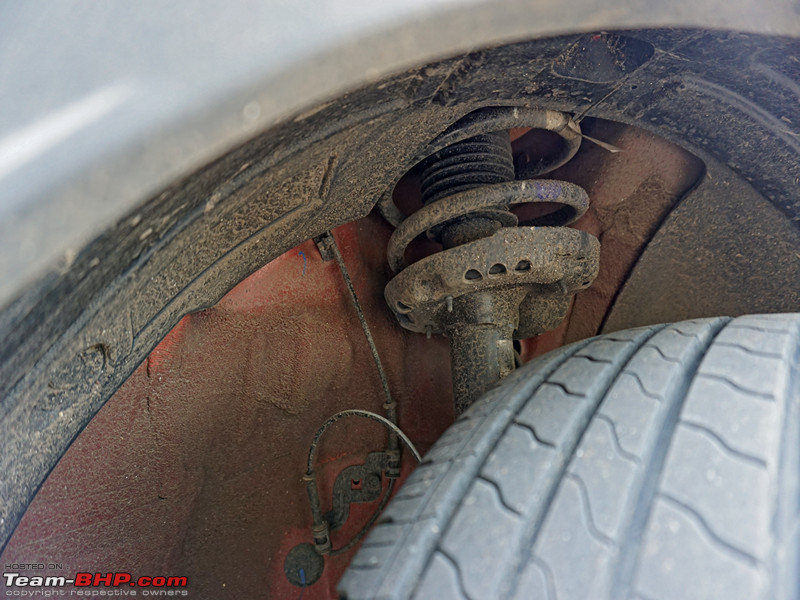 ...but none in the rear:  All of 3 clear markings to indicate the diesel car's diet! Anything to prevent accidentally putting in wrong fuel, we say! No spill protector provided though:  Petrol doesn't get any such labelling:  45L fuel tank is larger than the XUV300 and WR-V, but noticeably smaller than the EcoSport's 52L capacity:  No modern LED headlamps, yet the halogen projectors do a good job of lighting up the road ahead:  With the high beam engaged, the throw is excellent!  Recommended tyre pressure is 33 PSI all-round (36 PSI for the front and 38 PSI for the rear with a full load), which is on the higher side:  Rubber beading is soft, of good quality and well-fitted. Cabin insulation is very good. Typical Hyundai standards here:  All interior buttons are backlit in white:  Driver’s footwell gets 2 hooks to hold the floor mat in place:  Seatbelt warning lamp is accompanied by a chime. It comes on even if the front passenger hasn't buckled up   MID asks you to lower your speed when you cross 80 km/h and 120 km/h with two words - Reduce Speed. Again, typical Hyundai attention-to-detail when most manufacturers give you far simpler 80 / 120 km/h warnings:  A peek at the cruise-control display. The function works at speeds above 30 km/h:  Brown keyfob with silver buttons and chrome highlights is similar to the Elite i20, Creta etc. We like the design, but not the brown. It gets a panic notification button at the bottom. Press it with the keyfob within operational distance of the car and an SMS will be sent to 5 pre-saved emergency contacts through Blue Link. The car's horn will also start blowing and the turn-indicators will blink:  A low fuel alert is displayed on the infotainment system. It also asks you if you'd like to navigate to the nearest filling station. Pretty cool!  If you use the ICE without the engine running, the system will warn you that the battery is being discharged:  VIN is lightly engraved on a beam, below the driver's seat:  Inner sides of the front seats are lined with carpet material to prevent them from rubbing against the center console + damaging the leather:  Single wind-tone horn is very sad by Hyundai's standards. This car should definitely have had a premium dual-tone unit:  This horn disc inside the engine bay is for the security alarm:  Last edited by GTO : 19th September 2019 at 10:48. |
| |  (51)
Thanks (51)
Thanks
 |
| The following 51 BHPians Thank Aditya for this useful post: | ACFT, AjinkyaP, akshay81, aniyo, ashking101, AutoIndian, Bee, ChiragM, dailydriver, darklord, Déesse, Dennis, fiat_tarun, frankmehta, Gannu_1, gauravanekar, GTO, hemanth.anand, InControl, jailbird_fynix, jithin23, JoseVijay, Keynote, lemedico, MSAneesh, N33raj, nalinsaxena23, Omkar, PapaKiloSierra9, paragsachania, phoenixash, PraNeel, RavenAvi, Reinhard, sainyamk95, Samba, SanSabh, scorpio2107, sharktale, Sheel, Simat, Sk8r, SS-Traveller, sukiwa, supertinu, The_Outsider!, Turbanator, uday.ere, vaasu, VTec_KickedInYo, Xaos636 |
| | #14 |
| Team-BHP Support  | Re: Hyundai Venue : Official Review Thread moved from the Assembly Line to Official Reviews. Thanks for sharing! Rating thread a well-deserved 5 stars  . . Nice, neutral car. I’d taken the diesel along on a 3-day highway trip and enjoyed the drive. Is there a market for contemporary + high quality crossovers? Definitely. Despite the industry slowdown, the Venue has been consistently clocking 7,000 – 9,000 sales / month. Hyundai wants to push the 1.0 turbo over the 1.2 n/a. That’s why the latter is available only in the entry two variants. It’s a risky strategy for sure as the price difference between the 1.2 & 1.0 petrols is 1 lakh on the “S” variants, thereby pushing the price of the Venue petrols up (for the well-kitted variants). Interestingly, the price difference between the petrol & diesel is just ~24,000 rupees. This is obviously because the 1.0 petrol engine is now a direct-injection turbo-charged unit. Tough pick between the two, as the price of fuels is closer than ever too (~10 bucks / liter between petrol & diesel today). However, the fuel economy of that 1.4L diesel will be superior to the petrol’s. This is also why I’m disappointed that Hyundai hasn’t mated an automatic to the diesel. A Venue Diesel AT would cost merely Rs 24,000 more than the Petrol AT. Could’ve been on par if a torque converter was used instead of a pricey DCT, or even cheaper if it was an AMT (Hyundai does AMTs well). Last edited by GTO : 19th September 2019 at 11:40. |
| |  (28)
Thanks (28)
Thanks
 |
| The following 28 BHPians Thank GTO for this useful post: | ACFT, Added_flavor, Aditya, AutoIndian, bipinbn, ChiragM, dailydriver, Déesse, DrPriyankT, Gannu_1, gauravanekar, hemanth.anand, jailbird_fynix, JoseVijay, Keynote, N33raj, Omkar, paragsachania, RavenAvi, rednikhil, Reinhard, Samba, Scorpion 10, sukiwa, surjaonwheelz, The_Outsider!, uday.ere, VTec_KickedInYo |
| | #15 | |
| BHPian Join Date: Nov 2014 Location: Pune
Posts: 843
Thanked: 2,937 Times
| Re: Hyundai Venue : Official Review Quote:
This will be an interesting proposition to see for i20 and Venue. Note to TBHP Review team, can we have a review pipeline update or some info as which reviews are lined up in the forum. Though we get some byte and impressions from GTO now and then! As for now Hyundai has the Midas touch to its line-up! Last edited by surjaonwheelz : 19th September 2019 at 12:07. | |
| |  (2)
Thanks (2)
Thanks
 |
| The following 2 BHPians Thank surjaonwheelz for this useful post: | Aditya, rish_arora |
 |



